WASHINGTON D.C.—The Electronic Frontier Foundation (EFF) and five organizations defending free speech today urged the Supreme Court to strike down laws in Florida and Texas that let the states dictate certain speech social media sites must carry, violating the sites’ First Amendment rights to curate content they publish—a protection that benefits users by creating speech forums accommodating their diverse interests, viewpoints, and beliefs.
The court’s decisions about the constitutionality of the Florida and Texas laws—the first laws to inject government mandates into social media content moderation—will have a profound impact on the future of free speech. At stake is whether Americans’ speech on social media must adhere to government rules or be free of government interference.
Social media content moderation is highly problematic, and users are rightly often frustrated by the process and concerned about private censorship. But retaliatory laws allowing the government to interject itself into the process, in any form, raises serious First Amendment, and broader human rights, concerns, said EFF in a brief filed with the National Coalition Against Censorship, the Woodhull Freedom Foundation, Authors Alliance, Fight for The Future, and First Amendment Coalition.
“Users are far better off when publishers make editorial decisions free from government mandates,” said EFF Civil Liberties Director David Greene. “These laws would force social media sites to publish user posts that are at best, irrelevant, and, at worst, false, abusive, or harassing.
“The Supreme Court needs to send a strong message that the government can’t force online publishers to give their favored speech special treatment,” said Greene.
Social media sites should do a better job at being transparent about content moderation and self-regulate by adhering to the Santa Clara Principles on Transparency and Accountability in Content Moderation. But the Principles are not a template for government mandates.
The Texas law broadly mandates that online publishers can’t decline to publish others’ speech based on anyone’s viewpoint expressed on or off the platform, even when that speech violates the sites' rules. Content moderation practices that can be construed as viewpoint-based, which is virtually all of them, are barred by the law. Under it, sites that bar racist material, knowing their users object to it, would be forced to carry it. Sites catering to conservatives couldn’t block posts pushing liberal agendas.
The Florida law requires that social media sites grant special treatment to electoral candidates and “journalistic enterprises” and not apply their regular editorial practices to them, even if they violate the platforms' rules. The law gives preferential treatment to political candidates, preventing publishers at any point before an election from canceling their accounts or downgrading their posts or posts about them, giving them free rein to spread misinformation or post about content outside the site’s subject matter focus. Users not running for office, meanwhile, enjoy no similar privilege.
What’s more, the Florida law requires sites to disable algorithms with respect to political candidates, so their posts appear chronologically in users’ feeds, even if a user prefers a curated feed. And, in addition to dictating what speech social media sites must publish, the laws also place limits on sites' ability to amplify content, use algorithmic ranking, and add commentary to posts.
“The First Amendment generally prohibits government restrictions on speech based on content and viewpoint and protects private publisher ability to select what they want to say,” said Greene. “The Supreme Court should not grant states the power to force their preferred speech on users who would choose not to see it.”
“As a coalition that represents creators, readers, and audiences who rely on a diverse, vibrant, and free social media ecosystem for art, expression, and knowledge, the National Coalition Against Censorship hopes the Court will reaffirm that government control of media platforms is inherently at odds with an open internet, free expression, and the First Amendment,” said Lee Rowland, Executive Director of National Coalition Against Censorship.
“Woodhull is proud to lend its voice in support of online freedom and against government censorship of social media platforms,” said Ricci Joy Levy, President and CEO at Woodhull Freedom Foundation. “We understand the important freedoms that are at stake in this case and implore the Court to make the correct ruling, consistent with First Amendment jurisprudence.”
"Just as the press has the First Amendment right to exercise editorial discretion, social media platforms have the right to curate or moderate content as they choose. The government has no business telling private entities what speech they may or may not host or on what terms," said David Loy, Legal Director of the First Amendment Coalition.
For the brief:
https://www.eff.org/document/eff-brief-moodyvnetchoice
Leettaschmidt
Shared posts
In Landmark Battle Over Free Speech, EFF Urges Supreme Court to Strike Down Texas and Florida Laws that Let States Dictate What Speech Social Media Sites Must Publish
Copyright Cases Visual Artists Should Know: Part 3, Fair Use
As seen in parts 1 and part 2 of our blog series, where there is art, there are artists who love to push boundaries, particularly in copyright law. This is […]
The post Copyright Cases Visual Artists Should Know: Part 3, Fair Use appeared first on Copyright Alliance.
New Technology Will Help Clean Tampa Water
As the Environmental Protection Agency (EPA) prepares to release its drinking water regulations on per- and polyfluoroalkyl substances (PFAS), also known as “Forever Chemicals,” the Tampa Water Department is exploring a pioneering approach that will put it well ahead of the curve.
Suspended Ion Exchange, or “SIX,” will help address Tampa’s water quality needs. This sill also position the Water Department to meet the EPA’s future drinking water regulations. The Tampa Water Department is working to adopt this state-of-the-art technology at the David L. Tippin Water Treatment Facility. Once complete, this will become the first SIX facility in America and the largest in the world.

What are PFAS?
PFAS are man-made chemicals that are widely used and break down slowly over time. Researchers are trying to determine the impact of long-term PFAS exposure. However, scientific studies show that PFAS may be linked to negative health effects in humans. The EPA is expected to release its finalized regulations on six PFAS chemicals by the start of 2024. The proposed limits, which have yet to become official, are 4 parts per trillion. To put that into perspective, one part per trillion is equivalent to a drop of water in 20 Olympic-sized swimming pools.
Related: Tampa Bay Business Accelerator Focuses on Climate Technology
The David L. Tippin Water Treatment Facility monitors PFAS levels in its finished water as part of the EPA’s Unregulated Contaminant Monitoring Rule requirements. Testing completed over the last year showed some PFAS variants were detected in the samples, with the levels of two PFAS chemicals, PFOA and PFOS, detected slightly above the proposed limits in some samples.
Currently more than 33% of Florida’s water treatment facilities exceed the proposed limits.
Using technology to clean Tampa water
There are a limited number of technologies capable of minimizing PFAS levels in drinking water. While many utilities are still trying to determine how they might address the upcoming regulations, the Tampa Water Department already has a framework in development, and SIX is an essential piece of that solution.
“The City of Tampa and the Tampa Water Department are committed to providing our residents with clean, safe drinking water,” said Mayor Jane Castor. “There are a limited number of technologies capable of minimizing PFAS levels in drinking water, making this technology a critical investment to improve the quality of our water for generations to come.”
The Tampa Water Department initially piloted this technology in 2020. The pilot program showed that SIX will provide additional benefits, including:
- Reducing the amount of chemicals needed to treat our drinking water, saving the department approximately $1.4 million each year.
- Improving the quality of our drinking water.
- Increasing operational safety at the David L. Tippin Water Treatment Plant.
The results of the pilot were so promising that the SIX pilot is now being tested at the Howard F. Curren Advanced Wastewater Treatment Plant.
The post New Technology Will Help Clean Tampa Water appeared first on ModernGlobe.
Holocaust comparisons are overused -- but in the case of Hamas' Oct. 7 attack on Israel they may reflect more than just the emotional response of a traumatized people

Many observers have referred to the massacre of Israelis by Hamas on Oct. 7, 2023, as the deadliest attack against the Jewish people in a single day “since the Holocaust.”
As scholars who have spent decades studying the history of Israel’s relationship with the Holocaust, we have argued that the Holocaust should remain unique and not be compared with other atrocities. We have written against simplistic Holocaust analogies, like comparing mask and vaccine mandates during the COVID-19 pandemic to the Nazi persecution of the Jews, or the practice of labeling political opponents “Nazis.” Both seem to trivialize the memory of what is known as the Shoah, the Hebrew word for “catastrophe.”
But the Oct. 7 massacres perpetrated by Hamas changed our thinking.
Israeli identity and the Holocaust
Over the past 75 years, the collective memory of the Shoah has assumed a central place in Israeli national identity. The memory of the Holocaust has increasingly become the prism through which Israelis understand both their past and their present relationships with the Arab and Muslim world.
Israelis saw the Holocaust’s threat of annihilation echoed in many situations. In 1967, there was the waiting period before the Six-Day War, when the Egyptian leader Gamal Abdel Nasser threatened to “wipe Israel off the map.” It was there in the trauma of the Yom Kippur War in 1973 and the unexpected, simultaneous attacks by Egypt and Syria. When Israel destroyed the Iraqi nuclear reactor in 1981, Prime Minister Menachem Begin justified it with the explanation that “there won’t be another Holocaust in history.”
This association has only strengthened in the past 40 years with the 1982 Lebanon war, two Palestinian uprisings, known as intifadas, and with the present threat posed by a nuclear Iran.
All these events evoke the memory of the Holocaust and are understood within the collective memory of threats of annihilation. This phenomenon represents, for many Israelis, an inability to separate their current situation from the vulnerability of the diaspora Jewish past. And this conflation of past and present continues to play a central role in Israeli politics, foreign policy and public discourse.
The frequent comparisons between the Oct. 7 massacres and the Shoah are more, we believe, than just the default associations of a people submerged in Holocaust postmemory, which refers to inherited and imagined memories of subsequent generations who did not personally experience the trauma. In seeking to describe the depths of evil they witnessed on Oct. 7, Israelis were making more than just an emotional connection between the Holocaust and the Oct. 7 massacres.

To help explain the logic of that connection, specific and reasonable comparisons can be made to better understand Hamas’ traumatic and devastating massacre of Israelis. Below are a few of the many parallels:
1. Ideology and identification
Just as the Nazis aimed to annihilate the Jews, Hamas and affiliated terrorist organizations share the same objective: the destruction of Jews. The 1988 Hamas charter refers to “Jews” and not “Israelis” when calling for the destruction of these people.
While the 2017 Hamas covenant states that Hamas does not seek war with the Jews, but instead “wages a struggle against the Zionists who occupy Palestine,” the slaughter of Jews – many of whom were peace activists – in October has proven otherwise.
The national struggle of Hamas is predicated upon the conquest of land and elimination of the Jews. Hamas officials have subsequently promised to repeat Oct. 7 again and again until Israel is annihilated.
2. Indoctrination
While the racial antisemitism of the Nazi regime differs from the antisemitism employed in the fundamentalist Islamic version of Hamas, antisemitism is a key part of the struggle for both ideologies. Indoctrination from an early age aimed at the dehumanization of the Jews is a key part of both how Nazis taught young German students during the Third Reich and in how Hamas educates children in Gaza.
3. Methods of killing and survival
The horrors of Oct. 7 echo the brutal tactics Nazis used during the Holocaust, including not only murder but cruel humiliation of the victims. The testimonies of Oct. 7 survivors reveal the torture of parents and children, sometimes in front of each other, including rape and sexual violence, mocking and lingering in the murder process as the terrorists relished the atrocities they committed.
When the Jews in the Warsaw ghetto realized that the end was near, they worked for months to prepare hiding places for themselves in their homes and created improvised bunkers, doing whatever they could to avoid capture and deportation. They did not imagine that the Nazis would come to eliminate the ghetto in a different way, entering the ghetto with flamethrowers and burning down one building after another. Some Jews were burned alive, while others fled outside and fell into the hands of the Nazis.
On Oct. 7, victims in the kibbutzim and communities near Gaza hid in fortified safe rooms designed to protect them from rocket attacks. Hamas terrorists went from house to house, burning one after the other so that inhabitants would be forced to flee from their protected shelters. Others were burned in their homes.

4. Using Jews in the killing process
On Oct. 7, Hamas terrorists took a hostage from Nahal Oz, one of the kibbutzim in the south, and forced him to go from house to house to knock on doors and lure his neighbors outside. Afterward, they murdered him. Holocaust scholars have described such episodes from World War II in which Jews were forced to cooperate as “choiceless choices.”
5. Terminology
The word Shoah is used in the Bible to describe danger from neighboring nations, signifying distress, pain, torment, calamity and a “day of destruction.” While it later came to define the total Nazi extermination of Jews in the 1940s, multiple testimonies collected from survivors of the Oct. 7 massacres use the term once again today, echoing the biblical definition, to signal a day of desolation, darkness, destruction and gloom.
The words used to describe events are often loaded with emotional associations; the power and meaning of words that attempt to convey the depths of traumatic experiences cannot be discounted.
Not the same
There is a difference between pointing out similarities and creating shallow comparisons. We are aware of the tendency, especially in the political sphere, to resort to simplistic, symbolic and performative comparisons to the Holocaust – such as Israel’s ambassador to the United Nations, Gilad Erdan, donning a yellow star with the words “Never Again” on Oct. 31.
Oct. 7 is not the same as the Holocaust. Even so, we can use the study of the Holocaust to understand the traumatic and devastating encounters between Hamas terrorists and their victims on Oct. 7.
It might be a trivialization of the Holocaust to simply label Hamas as the “new Nazis,” but our analysis reveals that recognizing their eliminationist antisemitism means there can be no return to the pre-Oct. 7 status quo, when Israel’s policy was to accommodate Hamas’ control of the Gaza strip.
Despite the natural tendency to turn away from the most shocking and the most horrific manifestations of human evil, there are times when gazes must not be averted, when horror must be confronted in order to understand the motivations of the perpetrators and the responses of the victims and the survivors.
In this case, at what point do we ignore analogies that seem deliberate and intentional? As Holocaust scholars, we recognize why Israelis are stuck – and struck – by the traumatic nature of Oct. 7.
The authors do not work for, consult, own shares in or receive funding from any company or organization that would benefit from this article, and have disclosed no relevant affiliations beyond their academic appointment.
As the temperature rises, so do rates of domestic violence

Large parts of Australia are currently in the grip of a heatwave, and climate change means we’re in for more frequent and intense heat events into the future.
We know extreme heat can pose health risks, especially for vulnerable groups. But increasingly, research is highlighting a relationship between hot temperatures and violence.
Our team analysed close to one million reported incidents of domestic, non-domestic and sexual assaults over a 13 year period (2006-2018) in New South Wales. We examined trends related to season, temperature, and where the incidents occurred (inside or outside).
We found violence increased with warmer weather. But the effect of heat was greater on domestic violence than other types of violent crime. The reasons, and solutions, are complex.
Read more: Car accidents, drownings, violence: hotter temperatures will mean more deaths from injury
Hot weather, hot tempers
Rates of assault were higher in summer than in winter in most areas, except for a few places with snow tourism. Overall, domestic, non-domestic and sexual violence rose as temperatures increased from cool to warm.
On extreme heat days, non-domestic assaults outdoors declined, potentially because people move indoors seeking respite from the heat. However, domestic violence rates continued to increase with temperature, both inside and outside.
Sexual assaults both indoors and outdoors also increased in warm temperatures, but declined or plateaued in hot weather.
Why are violence and hot weather linked?
You’ve probably experienced the uncomfortable effects of hot weather, such as sweating, dehydration, lethargy and restless sleep. These effects can make people feel irritated, which may increase the likelihood of acting more aggressively.
Also, behavioural changes associated with hot weather may create more opportunities and motivation to act aggressively. For example, on warm and longer summer days we may be more likely to go out and socialise or drink more alcohol.
In extreme heat, we may retreat inside if we can, where there’s respite from the sun and potentially air conditioning. Given this, we might expect to see less of an association between violence and hot weather indoors. But our research found this wasn’t generally the case.
Domestic violence is more often experienced by women, at the hands of a family member or partner who they live with. During extreme heat, offenders and victims may not have practical ways to avoid the heat. The house may remain hot without access to air conditioning, or it may be too expensive to run.
Violence is also often said to occur “behind closed doors”, where there are fewer witnesses to intervene, and potentially more social stressors. As an example, COVID lockdowns were often associated with higher rates of intimate partner abuse.

One limitation of our study is that we used outdoor ambient air temperature to represent heat exposure, regardless of where the crime occurred. However, heat will vary significantly by location on a given day. For example, an indoor location like a bakery or factory could be hotter than outside at a shady park, and may remain hot regardless of the weather.
What about online?
Our team was interested to know whether temperature-related aggression can be seen outside of crime statistics, so we considered how anger is expressed on Twitter (now known as X).
In a previous study, we analysed emotions captured from more than 74 million tweets, looking for words or phrases that expressed rage or anger.
We found that generally the number of angry tweets (and in fact, tweets in general) decreased as temperatures moved from cool to warm. This may be partly because we get off our screens and enjoy the weather.
However, in very hot weather that trend plateaued or even reversed, suggesting angry tweets may rise in extreme heat. Similarly, studies have found online hate speech increases in extreme heat.

Reducing inequalities
Neither heat nor violence affect everyone equally. Both are influenced by social determinants of health.
Domestic violence is more likely to occur in disadvantaged areas. Likewise, lower socioeconomic populations tend to have higher heat exposure. This may be due to the urban heat island effect (where a city experiences warmer temperatures than surrounding rural areas), less access to air conditioning or private cars, or working outdoors.
While the drivers behind temperature-related violence are complex, there are things we can do. First, we need to address the big issues relating to domestic violence such as cultural norms, attitudes and legal provisions.
In heatwaves, we can provide inexpensive and accessible cool areas for those who need them. So-called “heat refuges” offer a safe space for people to linger, like at a library, swimming pool or community centre, and provide air conditioning, cold water and other facilities.
Increasing the amount of green space in cities could have a dual benefit. More urban greening is associated with lower urban heat island effect, and studies have also shown a link between more green space and less violent crime.
Read more: Extreme weather is landing more Australians in hospital – and heat is the biggest culprit
Our findings add to growing evidence that shows extreme weather events are associated with a range of poor health and social outcomes.
The effects of extreme weather in our communities demands more and stronger action on climate change.
The National Sexual Assault, Family and Domestic Violence Counselling Line – 1800 RESPECT (1800 737 732) – is available 24 hours a day, seven days a week for any Australian who has experienced, or is at risk of, family and domestic violence and/or sexual assault. You can also text the service on 0458 737 732.
Paul Beggs is affiliated with the Lancet Countdown.
Heather R. Stevens and Petra Graham do not work for, consult, own shares in or receive funding from any company or organisation that would benefit from this article, and have disclosed no relevant affiliations beyond their academic appointment.
Turning annual performance reviews into 'humble encounters' yields dividends for employees and managers

Every year, employees worldwide enter annual performance reviews with mixed feelings. Do employees enter these conversations with enthusiasm to learn new things? Rarely. Are managers eager to have these conversations and coach their employees on how they can improve in the coming year? No.
These meetings are typically experienced as difficult conversations. Opportunities for learning and relationship-building are often missed.
In an ideal world, employees would learn and improve from the feedback their manager provides in the annual review. But there are at least two obstacles that can stand in the way of that best-case scenario.
It can be hard to hear painful truths. Critical feedback can trigger defensive reactions: That’s wrong. Who are you to say? This is a disaster, and I’ll never be able to improve.
And, even if employees are receptive to the intended message, they may have trouble understanding the information and face difficulties implementing the feedback to improve their performance.
In an effort to get through, managers may try to soften their delivery. For example, they may use the much-maligned “feedback sandwich,” which bookends a critique between two compliments. But this tactic can obscure truthful and useful information, resulting in confusion, misunderstandings and worse.

We study organizational behavior and are especially interested in how people interact and communicate at work. Drawing from our research on humility and feedback, we suggest a new way for managers to approach performance reviews: Create what we call “humble encounters.”
By expressing humility, managers can transform performance reviews from monologues into dialogues, with greater learning and improvement as a result. Our studies indicate that when a team member expresses humility to a co-worker, it leads their partner to feel greater “psychological safety” – more comfortable sharing candid opinions and concerns without worrying about backlash or negative consequences. This, in turn, helps improve performance in the team.
Creating humble encounters
Humility has a few key ingredients: You must be willing to view yourself accurately, as you really are. But that’s not enough to create a humble encounter. You must also show that you are teachable by exhibiting openness to feedback, ideas and suggestions. Finally, it’s critical that you acknowledge and express appreciation for the contributions that others make.
So, how might a manager do all this in a performance review?
You can signal that you’re willing to view yourself accurately by sharing personal experiences of dealing with challenges: “I also struggled with this issue when I first entered the company.” By sharing your own challenges and how you worked through them, you signal that you’re aware of your own weaknesses and vulnerabilities, as well as your strengths and achievements.
You can signal teachability by demonstrating that you’re open to learning from others. Managers can use what organizational culture experts Edgar and Peter Schein call “humble inquiry” – asking questions you don’t already know the answer to, listening intentionally and responding with curiosity.
Be mindful of assumptions implicitly conveyed to the listener by how you phrase your questions. Negative assumption questions – like “What triggers you to argue with your co-workers?” – presuppose a problem. The employee might be surprised by this question and the assumption behind it because they don’t remember the last time they argued with someone at work. A negative-assumption question can help clarify undesirable behaviors if they are indeed happening, but at the same time it can signal distrust and hinder the receptivity of the receiver.
Another way to express humility is by good listening. It includes three crucial elements: paying attention to the speaker, showing positive intentions toward the speaker, and demonstrating that you understand their message. Managers who listen well to their employees elicit better performance and establish stronger relationships with them.

Spotlighting an employee’s strengths and contributions is active acknowledgment of the employee’s value without the manager devaluing their own. During the annual review, it’s possible to recognize an employee’s strengths while still providing developmental feedback.
Managers should provide support by conveying a sense of care, understanding and validation: “I’m giving you these comments because I have very high expectations, and I know you can reach them.” Using language that communicates support fosters trust and a sense of belonging, thus breaking down walls of defensiveness.
Humble encounters enable growth
By modeling humility, managers provide employees with two key, seemingly contradictory signals.
They show relational acceptance – a signal that they accept the employee as they are, thereby calming feelings of threat and defensiveness. At the same time, they also communicate an expectation of change. Learning and improvement are not only possible but necessary for the employee to reach their full potential in the job.
In response to managers’ humility, employees will reciprocate humble behaviors, showing more willingness to view themselves accurately, be teachable and appreciate others’ contributions.
Managers might be concerned that expressing humility might signal weakness. However, research shows that this is not the case. When leaders are perceived to be humble, they are also seen as effective, competent and charismatic. Therefore, being a humble leader has benefits not only for employees, but also for the leader’s reputation.
Humble encounters can transform annual reviews into a more positive and enriching experience for both managers and employees. By enacting the three key aspects of humility – a willingness to view yourself accurately, teachability and appreciation for others’ contributions – you can both change your employees’ learning curve and strengthen your relationship with them.
Michal Lehmann receives funding from The John Templeton Foundation, Grant # 62265, Applied Research on Intellectual Humility. Taya Cohen's research on honesty and difficult conversation was supported by the John Templeton Foundation (grant #61842: The Honesty Project). The opinions expressed in this article are those of the authors and do not necessarily reflect the views of the sponsor.
This article was produced with support from UC Berkeley's Greater Good Science Center and the John Templeton Foundation as part of the GGSC's initiative on Expanding Awareness of the Science of Intellectual Humility.
The disagreement between two climate scientists that will decide our future

Getting to net zero emissions by mid-century is conventionally understood as humanity’s best hope for keeping Earth’s surface temperature (already 1.2°C above its pre-industrial level) from increasing well beyond 1.5°C – potentially reaching a point at which it could cause widespread societal breakdown.
At least one prominent climate scientist, however, disagrees.
James Hansen of Columbia University in the US published a paper with colleagues in November which claims temperatures are set to rise further and faster than the predictions of the Intergovernmental Panel on Climate Change (IPCC). In his view, the 1.5°C target is dead.
He also claims net zero is no longer sufficient to prevent warming of more than 2°C. To regain some control over Earth’s rising temperature, Hansen supports accelerating the retirement of fossil fuels, greater cooperation between major polluters that accommodates the needs of the developing world and, controversially, intervening in Earth’s “radiation balance” (the difference between incoming and outgoing light and heat) to cool the planet’s surface.
There would probably be wide support for the first two prescriptions. But Hansen’s support for what amounts to the deliberate reduction of sunlight reaching Earth’s surface has brought into the open an idea that makes many uncomfortable.
Michael Mann from the University of Pennsylvania in the US and another titan of climate science, spoke for many when he dismissed solar radiation management as “potentially very dangerous” and a “desperate action” motivated by the “fallacy … that large-scale warming will be substantially greater than current-generation models project”.
Their positions are irreconcilable. So who is right – Hansen or Mann?
Earth’s radiation balance
First, an explanation.
There are only two ways to reduce global warming. One is to increase the amount of heat radiated from Earth’s surface that escapes to space. The other is to increase the amount of sunlight reflected back to space before it lands on something – whether a particle in the atmosphere or something on Earth’s surface – and is converted to heat.
There are many ways to do both. Anything that reduces the amount of greenhouse gas in the atmosphere will let more heat escape to space (replacing fossil fuels with renewables, eating less meat and tilling the soil less for example). Anything that makes the planet brighter will reflect more sunlight to space (such as refreezing the Arctic, making clouds whiter or putting more reflective particles in the atmosphere).
But the key difference between the two, in terms of their impact on global warming, is their response time. That is, the time it takes for a change in the factors that allow more heat to escape or sunlight to be reflected to appear as a change in Earth’s surface temperature.
Intervening to speed up the loss of heat from Earth’s surface cools the planet slowly, over decades and longer. Intervening to increase the sunlight Earth reflects back to space cools the planet more or less immediately.
The essence of the dispute between Mann and Hansen is whether reducing greenhouse gases, by a combination of reducing new emissions and permanently removing past emissions from the atmosphere, is now enough on its own to prevent warming from reaching levels that threaten economic and social stability.
Mann says it is. Hansen says that, while doing these things remains essential, it is no longer sufficient and we must also make Earth more reflective.
When will warming end?
Mann aligns with IPCC orthodoxy when he says that emissions reaching net zero will result, within a decade or two, in Earth’s surface temperature stabilising at the level it has then reached.
In effect, there is no significant warming in the pipeline from past emissions. All future warming will be due to future emissions. This is the basis for the global policy imperative to get to net zero.
In his new paper, Hansen argues that if the atmospheric concentration of greenhouse gases remains close to its current level, the surface temperature will stabilise after several hundred years between 8°C and 10°C above the pre-industrial level.
Of this, at least 2°C will emerge by mid-century, and probably a further 3°C a century from now. A temperature increase of this magnitude would be catastrophic for life on Earth. Hansen adds that to avoid such an outcome, brightening Earth is now necessary to halt the warming in the pipeline from past emissions.

But at the same time, we must also largely eliminate emissions if we are to stop recreating this problem in the future.
Still getting hotter…
We are scientists who study the feasibility and effectiveness of alternative responses to climate change, addressing both the engineering and political realities of enabling change at the scale and speed necessary.
We find Mann’s rebuttal of Hansen’s claims unconvincing. Crucially, Mann does not engage directly with Hansen’s analysis of new data covering the last 65 million years.
Hansen explains how the models used by IPCC scientists to assess future climate scenarios have significantly underestimated the warming effect of increased greenhouse gas emissions, the cooling effect of aerosols and how long the climate takes to respond to these changes.
Besides greenhouse gases, humanity also emits aerosols. These are tiny particles comprising a wide range of chemicals. Some, such as the sulphur dioxide emitted when coal and oil are burned, offset the warming from greenhouse gases by reflecting sunlight back to space.
Others, such as soot, have the opposite effect and add to warming. The cooling aerosols dominate by a large margin.
Hansen projects that in coming months, lower levels of aerosol pollution from shipping will cause warming of as much as 0.5°C more than IPCC models have predicted. This will take global warming close to 2°C as early as next year, although it is likely then to fall slightly as the present El Niño wanes.
Underpinning Hansen’s argument is his conviction that the climate is more sensitive to greenhouse gases than previously reported. The IPCC estimates that doubling atmospheric CO₂ raises Earth’s temperature by 3°C. Hansen calculates it to be 4.8°C.
This, and the much longer climate response time that Hansen calculates from the historical record, would have a significant impact on climate model projections.
Time for reflection
The differences between Mann and Hansen are significant for the global response to climate change.
Mann says that allowing emissions to reach net zero by mid-century is sufficient, while Hansen maintains that on its own it would be disastrous and that steps must now be taken in addition to brighten the planet.
Brightening Earth could also reverse the reductions in reflectivity already caused by climate change. Data indicates that from 1998 to 2017, Earth dimmed by about 0.5 watts per square metre, largely due to the loss of ice.
Given what’s at stake, we hope Mann and Hansen resolve these differences quickly to help the public and policymakers understand what it will take to minimise the likelihood of imminent massive and widespread ecosystem destruction and its disastrous effects on humanity.
While 1.5°C may be dead, there may still be time to prevent cascading system failures. But not if we continue to squabble over the nature and extent of the risks.

Don’t have time to read about climate change as much as you’d like?
Get a weekly roundup in your inbox instead. Every Wednesday, The Conversation’s environment editor writes Imagine, a short email that goes a little deeper into just one climate issue. Join the 20,000+ readers who’ve subscribed so far.
The authors do not work for, consult, own shares in or receive funding from any company or organization that would benefit from this article, and have disclosed no relevant affiliations beyond their academic appointment.
The Napoléon that Ridley Scott and Hollywood won’t let you see
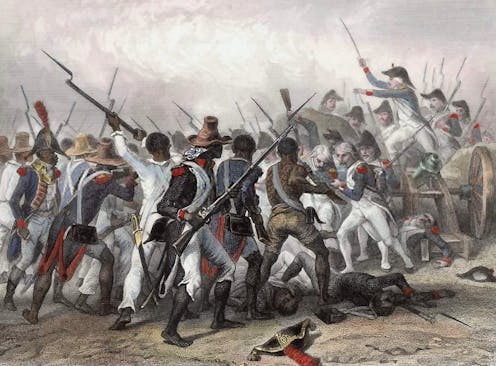
Critics have been raking Ridley Scott’s new movie about Napoléon Bonaparte over the coals for its many historical inaccuracies.
As a scholar of French colonialism and slavery who studies historical fiction, or the fictionalization of real events, I was much less bothered by most of the liberties taken in “Napoleon” – although shooting cannons at the pyramids did seem like one indulgence too far.
I have argued elsewhere that historical fictions need not necessarily be judged by adherence to facts. Instead, inventiveness, creativity, ideology and, ultimately, storytelling power are what matter most.
But in lieu of offering a fresh and imaginative take on Napoléon, Scott’s film rehearsed the well-known battles of Austerlitz, Wagram and Waterloo, while erasing perhaps the most momentous – and consequential – of Bonaparte’s military campaigns.
As with every other Napoléon movie, Scott’s version will leave viewers with no understanding of the genocidal war to restore slavery that Bonaparte waged against Black revolutionaries in the French colony of Saint-Domingue – what’s known as Haiti today.
To me, leaving out this history is akin to making a movie about Hitler without mentioning the Holocaust.
‘I am for the whites, because I am white’
France’s seemingly eternal on-again, off-again war with Great Britain did not change the immediate boundaries of either country. These wars were often fought over land in the American hemisphere and included a historic contest over Martinique, a small island in the Caribbean, whose fate had far-reaching repercussions for slavery.
In 1794, following three years of slave rebellions in Saint-Domingue – events now known as the Haitian Revolution – the French government abolished slavery in all French overseas territories.
Martinique, however, was not included: The French had recently lost the island to the British in battle.
In a 1799 speech to the French government, Bonaparte explained that if he had been in Martinique at the time the French lost the colony, he would have been on the side of the British – because they never dared to abolish slavery.
“I am for the whites, because I am white,” Bonaparte said. “I have no other reason, and this is the right one. How could anyone have granted freedom to Africans, to men who had no civilization.”
Once he rose to power, Bonaparte signed the 1802 Treaty of Amiens with the British, which returned Martinique to French rule. Afterward, he passed a law permitting slavery to continue in Martinique. And in July 1802, Bonaparte formally reinstated slavery on Guadeloupe, another French colony in the Caribbean. Slavery then persisted in France’s overseas empire until 1848, long after his death in 1821.
Meanwhile, in Saint-Domingue, Bonaparte authorized his generals to eliminate the majority of the adult Black population, and he signed a law to reinstate the slave trade to the island.
A Black general’s rise
For the mission to succeed, Bonaparte’s troops would have to contend with a formerly enslaved man called Toussaint Louverture, who had become a prominent leader during the early years of the Haitian Revolution.
After general emancipation, when the Black population had become citizens – rather than slaves – of France, Louverture joined the French army. He went on to play a key role in helping France combat and eventually defeat Spanish and British forces, who had since invaded the colony in an attempt to take it over.
Recognizing his military prowess, the French consistently promoted Louverture until he became the second Black general in a French army – after General Thomas-Alexandre Dumas, father of the famous French novelist Alexandre Dumas. (Thomas-Alexandre Dumas incidentally appears in the film as a character with a nonspeaking part.)
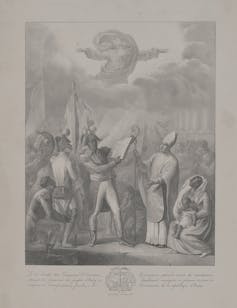
In 1801, as a testament to his growing authority, Louverture issued a famous constitution that appointed him governor-general of the whole island. Yet he still professed fealty to France even as the colony became semi-autonomous.
By then, however, Bonaparte had assumed power as first consul of France – and had made it his mission to “annihilate the government of the Blacks” in Saint-Domingue so he could bring back slavery.
In January 1802, Bonaparte sent his brother-in-law Charles Victor Emmanuel Leclerc to Saint-Domingue with tens of thousands of French troops.
Arrest Louverture and reinstate slavery.
The fall of Louverture
One of the film’s writers, David Scarpa, said Napoléon represents for him “the classic example of the benevolent dictator.”
If that Napoléon ever did exist, Louverture never met him.
In June 1802, Napoléon’s army arrested Louverture and deported him to France. As Louverture wasted away in a French prison, Bonaparte refused to put Louverture on trial. Throughout his incarceration, the guards at the jail denied Louverture food, water, heat and medical care. Louverture subsequently starved and froze to death.
With Louverture gone, Napoléon’s army operated with more bloodlust than ever before. In addition to conventional weapons, his troops fought the freedom fighters with floating gas chambers, mass drownings and dog attacks – all in the name of restoring slavery.
The Black freedom fighters, now calling themselves the armée indigène, led by Haiti’s founder General Jean-Jacques Dessalines, definitively defeated French forces in the historic Battle of Vertières on Nov. 18, 1803. On Jan. 1, 1804, they officially declared independence from France and changed the name of the island to Haiti.
‘A fatal move’
If the filmmakers had included Napoléon’s failed mission to restore slavery in Saint-Domingue, it could have served as a propitious moment to tie the movie back to one of its only coherent arcs: Napoléon’s undying love for Joséphine de Beauharnais, his first wife.
In one memorable scene in the film, Joséphine tells Bonaparte that he is nothing without her, and he agrees.

However, Joséphine’s posthumously published memoir suggests that Bonaparte disregarded his wife’s most prescient counsel. Joséphine wrote that she urged her husband not to send an expedition to Saint-Domingue, prophesying this as a “fatal move” that “would forever take this beautiful colony away from France.” She advised Bonaparte, alternatively, to “keep Toussaint Louverture there. That is the man required to govern the Blacks.”
She subsequently asked him, “What complaints could you have against this leader of the Blacks? He has always maintained correspondence with you; he has done even more, he has given you, in some sense, his children for hostages.”
Louverture’s children had attended Paris’ storied Collège de la Marche, alongside the children of other prominent Black Saint-Domingue officials. Although Bonaparte ended up sending Louverture’s children back to the colony with Leclerc, another Black general from Saint-Domingue who fought to oppose slavery’s reinstatement was not so lucky.
Just before Bonaparte’s troops began their genocidal war in the name of restoring slavery, Haiti’s future king, General Henry Christophe, sent his son, François Ferdinand, to the Collège de la Marche.
After the Haitian revolutionaries defeated France and declared the island independent in 1804, Bonaparte ordered the school closed. Many of its Black students, like young Ferdinand, were then thrown into orphanages. The abandoned child died alone in July 1805 at the age of 11.
Only at the end of his life, during his second exile on the remote island of St. Helena, did Napoléon express remorse for any of this.
“I can only reproach myself for the attempt on that colony,” the defunct emperor said. “I should have contented myself with governing it through Toussaint.”
A missed opportunity
By including some of this rich material, Ridley Scott could have made a truly original film with historical and contemporary relevance.
After all, Napoléon’s history of trying to stop the Haitian Revolution – the most significant revolution for freedom the modern world has ever seen – has never been depicted on a Hollywood screen.
Instead, hiding behind beautiful cinematography, magnificent costuming and Vanessa Kirby’s masterful portrayal of Joséphine, Scott ultimately produced an unimaginative film about the already well-trodden military successes and failures of the man depicted as having literally crowned himself France’s emperor.
If “Napoleon” doesn’t exactly glorify its main subject, its creators certainly seemed to sympathize with the man whose wars were responsible for more than 3,000,000 deaths, as the film’s final caption reads.
The film did not say whether that number includes the tens of thousands of Black people Napoléon’s army killed in Saint-Domingue.
Marlene Daut does not work for, consult, own shares in or receive funding from any company or organization that would benefit from this article, and has disclosed no relevant affiliations beyond their academic appointment.
Why Russians still support Vladimir Putin and the war in Ukraine
Russian president Vladimir Putin has announced he intends to run in the 2024 presidential election. Putin is almost certain to win what would be his fifth term as Russian president.
The news comes as little surprise. Putin has led Russia for 24 years and polls suggest Russia’s ongoing military campaign in Ukraine has bolstered support for him.
Opinion polls
In September, Russian pollsters the Levada Center conducted a survey of Russian attitudes toward the war in Ukraine. When asked whether they supported the Russian military’s actions in Ukraine, 73 per cent of respondents said “yes” or “definitely yes.” In February 2022, the month of Russia’s invasion, that number was 68 per cent.
Some might be skeptical of polls coming out of Russia, but it should be noted these figures are from an organization that has been deemed a “foreign agent” by the Russian government. It doesn’t matter who does the polling — the data suggests a majority of Russians support the war effort.
At the same time, Putin’s personal approval rating has remained high, running at around 80 per cent for some time, according to Levada. A more recent poll by Russia’s Public Opinion Foundation indicates around 78 per cent of Russians approve of Putin’s work.
However, there was a drop in support for both the war and Putin in late 2022. In the fall of 2022, the Russian government launched a major mobilization of reservists for the armed forces in response to Ukrainian battlefield successes, first near Kyiv and then Kharkhiv. This led to many young men leaving the country to avoid being drafted into the military.
Russian forces also pulled back from their foothold on the western bank of the Dnipro River at Kherson. Unease with the situation among Russians was reflected in polling numbers during that period, and was tangible on the ground when I visited Moscow and Murmansk in October 2022.
The Russian government’s zero tolerance for public opposition to the war or Putin undoubtedly has some bearing on improved polling. Russia’s defeat of Ukraine’s summer counteroffensive also certainly boosted Russian confidence. Furthermore, the number of Russian soldiers killed in Ukraine remains a closely guarded secret.
However, as I found during time spent in both Moscow and Ryazan in November 2023, many older Russians in particular — from different walks of life — express genuine support for both the war and their president. Why?
Backing Russia’s war narrative
The answer to this question lies in part in a combination of Russian government policies and western reactions to the war.
Many Russians undoubtedly accept the government narrative explaining the reasons for the war. Those reasons are not the same as they were back in February 2022, but have morphed into something bigger and more existential.
Back in February 2022, Russia went to war in Ukraine with the justification of protecting the rights of those identifying as Russian in the Donbas, and to prevent further NATO encroachment into the former Soviet space. The “de-Nazification” of eastern Ukraine was also tacked on to these aims.
Defending the rights of ethnic Russians in eastern Ukraine clearly resonated to some extent with the Russian population at the beginning of the war. However, the threat of NATO expansion was perhaps not as powerful an argument for the war back then as the more recent idea that a hypocritical West is out to “cancel” Russian political and economic power.
Money certainly plays a role in maintaining support. The Russian government has increased military wages to keep morale up. As of last September, the minimum monthly wage being offered to those signing up was three times the national average. In June, the government announced it would increase military salaries by 10.5 per cent.
Western hypocrisy plays into Russia’s hands
Through their actions, western powers have made it easy for the Russian government to point to western hypocrisy. Unwavering western support for Israel’s war in Gaza has further highlighted that the United States in particular has one set of rules for its friends, and another for its enemies.
A U.S.-backed Israel has been slaughtering civilians at a rate far exceeding anything Russian forces have done in Ukraine. And while western officials were quick to condemn Russian attacks on civilians, condemnations of Israel’s actions have been muted or non-existent.
Moreover, western attempts to isolate Russia economically and culturally have made the Russian government’s narrative that the West is out to cancel Russia easier to sell to the public.
At the same time, blunders by some western governments have also made it easier for Russia to sell the narrative it is fighting fascism in Ukraine. The recent Yaroslav Hunka debacle in the Canadian Parliament was a propaganda gift for the Russian government. Western celebration of Ukrainian units with fascist ties like the Azov Battalion only makes matters worse.
New economic ties
Unprecedented western sanctions aimed at isolating the Russian economy from the world have not succeeded in changing Russian actions in Ukraine.
Instead, increased animosity with the West appears to have pushed Russia to deepen ties with China and other international partners.
Early in the war, Putin touted what he called Russia’s ability to “fully provide itself with natural resources.” While inflation is high, Russian stores remain full and unemployment remains low. The International Monetary Fund did recently lower Russia’s economic growth forecast for 2024, but that forecast still compares favourably to countries like Canada, France, Italy and the United Kingdom.
Palatable or not in the West, Russia’s ability to seemingly resist sanctions and fight off a Ukrainian NATO-backed counteroffensive has contributed to rising public support for the war and for Putin.
Alexander Hill does not work for, consult, own shares in or receive funding from any company or organisation that would benefit from this article, and has disclosed no relevant affiliations beyond their academic appointment.
What's the point of giving gifts? An anthropologist explains this ancient part of being human

Have you planned out your holiday gift giving yet? If you’re anything like me, you might be waiting until the last minute. But whether every single present is already wrapped and ready, or you’ll hit the shops on Christmas Eve, giving gifts is a curious but central part of being human.
While researching my new book, “So Much Stuff,” on how humanity has come to depend on tools and technology over the last 3 million years, I became fascinated by the purpose of giving things away. Why would people simply hand over something precious or valuable when they could use it themselves?
To me as an anthropologist, this is an especially powerful question because giving gifts likely has ancient roots. And gifts can be found in every known culture around the world.
So, what explains the power of the present?
Undoubtedly, gifts serve lots of purposes. Some psychologists have observed a “warm glow” – an intrinsic delight – that’s associated with giving presents. Theologians have noted how gifting is a way to express moral values, such as love, kindness and gratitude, in Catholicism, Buddhism and Islam. And philosophers ranging from Seneca to Friedrich Nietzsche regarded gifting as the best demonstration of selflessness. It’s little wonder that gifts are a central part of Hannukah, Christmas, Kwanzaa and other winter holidays – and that some people may even be tempted to regard Black Friday, the opening of the year-end shopping season, as a holiday in itself.
But of all the explanations for why people give gifts, the one I find most convincing was offered in 1925 by a French anthropologist named Marcel Mauss.

Giving, receiving, reciprocating
Like many anthropologists, Mauss was puzzled by societies in which gifts were extravagantly given away.
For example, along the northwest coast of Canada and the United States, Indigenous peoples conduct potlatch ceremonies. In these dayslong feasts, hosts give away immense amounts of property. Consider a famous potlatch in 1921, held by a clan leader of the Kwakwaka’wakw Nation in Canada who gave community members 400 sacks of flour, heaps of blankets, sewing machines, furniture, canoes, gas-powered boats and even pool tables.
In a now-famous essay titled “The Gift,” originally published almost a century ago, Mauss sees potlaches as an extreme form of gifting. Yet, he suggests this behavior is totally recognizable in most every human society: We give things away even when keeping them for ourselves would seem to make much more economic and evolutionary sense.
Mauss observed that gifts create three separate but inextricably related actions. Gifts are given, received and reciprocated.
The first act of giving establishes the virtues of the gift giver. They express their generosity, kindness and honor.
The act of receiving the gift, in turn, shows a person’s willingness to be honored. This is a way for the receiver to show their own generosity, that they are willing to accept what was offered to them.
The third component of gift giving is reciprocity, returning in kind what was first given. Essentially, the person who received the gift is now expected – implicitly or explicitly – to give a gift back to the original giver.
But then, of course, once the first person gets something back, they must return yet another gift to the person who received the original gift. In this way, gifting becomes an endless loop of giving and receiving, giving and receiving.
This last step – reciprocity – is what makes gifts unique. Unlike buying something at a store, in which the exchange ends when money is traded for goods, giving gifts builds and sustains relationships. This relationship between the gift giver and receiver is bound up with morality. Gifting is an expression of fairness because each present is generally of equal or greater value than what was last given. And gifting is an expression of respect because it shows a willingness to honor the other person.
In these ways, gifting tethers people together. It keeps people connected in an infinite cycle of mutual obligations.

Giving better gifts
Are modern-day consumers unknowingly embodying Mauss’ theory a little too well? After all, many people today suffer not from the lack of gifts, but from an overabundance.
Gallup reports that the average American holiday shopper estimates they’ll spend US$975 on presents in 2023, the highest amount since this survey began in 1999.
And many gifts are simply thrown out. In the 2019 holiday season, it was estimated that more than $15 billion of gifts purchased by Americans were unwanted, with 4% going directly to the landfill. This year, holiday spending is expected to increase in the U.K., Canada, Japan and elsewhere.
Modern-day gifting practices may be the source of both awe and anger. On the one hand, by giving presents you are engaging in an ancient behavior that makes us human by growing and sustaining our relationships. On the other hand, it seems as if some societies might be using the holiday season as an excuse to simply consume more and more.
Mauss’ ideas do not promote runaway consumerism. On the contrary, his explanations of gifts suggest that the more meaningful and personal the present, the greater the respect and honor being shown. A truly thoughtful gift is far less likely to end up in a dump. And vintage, upcycled, handmade goods – or a personalized experience such as a food tour or hot air balloon ride – might even be more valued than an expensive item mass-produced on the other side of the world, shipped across oceans and packaged in plastic.
Quality gifts can speak to your values and more meaningfully sustain your relationships.
Chip Colwell receives funding from the National Endowment for the Humanities and National Science Foundation. He is affiliated with the Wenner-Gren Foundation and SAPIENS.
Before he was House speaker, Mike Johnson represented a creationist museum in court. Here’s what that episode reveals about his politics
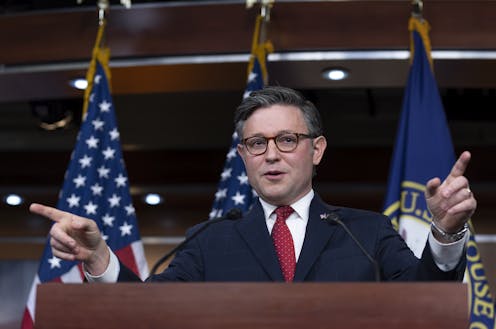
Speaker of the House Mike Johnson has been the subject of considerable media attention following his elevation to the post on Oct. 25, 2023. Since his appointment, news reports have highlighted the fact that he was one of the House leaders against certifying the 2020 election of Joe Biden to the presidency, and that he is known to be stridently anti-abortion and anti-LGBTQ+.
Comparing himself to Moses, in a speech at a gala on Dec. 5, 2023, Johnson suggested that God cleared the way for him to be speaker of the House.
In the words of Public Religion Research Institute President Robert Jones, Johnson is “a near-textbook example of white Christian nationalism – the belief that God intended America to be a new promised land for European Christians.”
As historian John Fea has noted, Johnson is “a culture warrior with deep connections to the Christian Right.”
While it might not seem obvious, one of those connections includes his legal work on behalf of Ark Encounter, the massive tourist site in Kentucky run by Answers in Genesis, or AiG, and its CEO, Ken Ham. Ark Encounter and its companion site, the Creation Museum, propagate Young Earth Creationism, or YEC, which is the notion that the Earth is but 6,000 years old and that the geological formations seen today were formed by a global flood that took place around 4,000 years ago.
The state of Kentucky offers tax incentives for large tourist sites. In 2014, two years before Ark Encounter opened, the state determined that the tourist site was ineligible for these tax rebates. A primary reason for rejection was that all Ark Encounter employees are required to affirm a lengthy faith statement, which, according to Tourism Secretary Bob Stewart, “violates the separation of church and state provisions of the Constitution.”
As an attorney for Freedom Guard, a conservative religious legal advocacy law group, Johnson sued on behalf of Ark Encounter, arguing that in denying the tax rebates, the state was discriminating on the basis of religion. Johnson and the Ark prevailed, and Ark Encounter received the state’s tax incentives.
As a scholar of American evangelicalism, I argue that Johnson’s association with Ark Encounter makes much sense, given the very strong connection between Young Earth Creationism and Christian Right politics. And this connection is old.
Answers in Genesis and the Christian Right
In his 2021 book, “Red Dynamite,” historian Carl Weinberg established that for the past century, Young Earth creationists have made the case that evolutionary science makes people behave in “an immoral, ‘beastly’ or ‘animalistic’ way,” especially when it comes to sex and violence.
More than this, Weinberg argues that, for Young Earth creationists, evolution has been understood as the “backbone” of a communist philosophy, a “socialist, Marxist philosophy” that promotes a “spirit of rebellion” in America today.
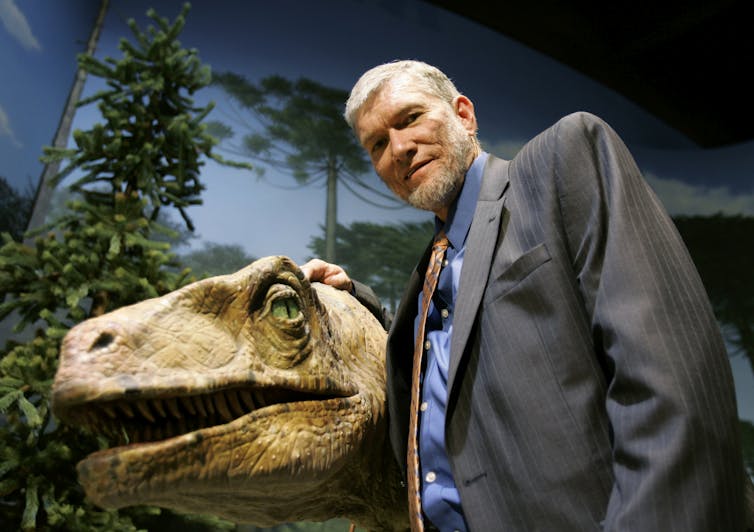
As rhetorical scholar Susan L. Trollinger and I document in our 2016 book, “Righting America at the Creation Museum,” AiG continues this Christian Right tradition through its extensive online presence, its museum and now Ark Encounter.
According to Ham and AiG, “public schools are churches of secular humanism and … most of the teachers are … imposing an anti-God worldview on generations of students.” Sexual immorality, LGBTQ+ activism and the rejection of patriarchy are, according to AiG, signs of the resultant cultural corruption. Ham claims that a once-Christian America – with Bible-believing founders who had no intention of separating church and state – has, since the 1960s, been dragged downward. In his 2012 book, “The Lie,” Ham asserts that this will eventually “result in the outlawing of Christianity.”
In the past few years, AiG has doubled down on its culture war commitments. For example, in March 2021 the AiG Statement of Faith – signed by all employees and volunteers – was expanded from 29 provisions to 46 provisions. This includes article 29, which requires signers to affirm that “‘social justice’ … as defined in modern terminology” is “anti-biblical and destructive to human flourishing.” Then there is article 32, which says that “gender and biological sex are equivalent and cannot be separated.”
Rejecting the dangers of global warming and the notion that governments should intervene to reverse this trend, AiG’s Ham has asserted that “zealous climate activism is a false religion with false prophets.” According to him, climate activists are misled because they begin with human reason and not the Bible, and because they hold to evolution and an ancient Earth.
In a similar vein, an AiG spokesperson blasted mainstream scientists and others who focused on the dangers of COVID-19, arguing that they were simply generating hysteria “about a virus that doesn’t kill very many people at all.” AiG’s CEO lamented on his social media post that “the COVID-19 situation has been weaponized in many places to use against Christians.”
Mike Johnson and AiG beliefs
Johnson has effusively praised Ark Encounter as “a strategic and really creative … way to bring people to this recognition of the truth that what we read in the Bible are actual historical events.”
Johnson also shares with AiG’s Ham that government should not intervene when it comes to global warming, particularly given that, like Ham, he does not believe “that the climate is changing because we drive SUVs.”
He also shares with the folks at AiG the conviction that belief in evolution results in immoral behavior. For example, Johnson has blamed school shootings on the fact that “we have taught a whole generation … of Americans that there is no right and wrong. It’s all about survival of the fittest, and you evolve from primordial slime,” and so “why is that life of any sacred value?”
In this, Johnson is echoing AiG authors and speakers. For example, in response to the 2007 shooting in a high school in Jokela, Finland, which left nine dead, including the shooter, Bodie Hodge, an AiG researcher and author, asserted: “So long as evolutionism is forced onto children (no God, people are animals, no right and wrong, etc.) and so long as they believe it and reject accountability to their Creator, then we can expect more of these types of gross and inappropriate actions.”
In short, Johnson’s political commitments fit neatly into the politics of AiG and the Young Earth Creationism ecosystem. This matters politically, particularly given that a significant subset of American evangelicals adheres to Young Earth Creationism.
William Trollinger does not work for, consult, own shares in or receive funding from any company or organization that would benefit from this article, and has disclosed no relevant affiliations beyond their academic appointment.
Shop Local! Check Out the Tampa Bay Murals Calendar
Experience the vibrant tapestry of Tampa art scene with an exclusive Tampa Bay murals calendar that celebrates some of the most well know art pieces in the area. Each month unveils a stunning visual journey, showcasing the region’s diverse artistic expressions that adorn its streets, capturing the essence of Tampa Bay’s rich creative spirit.
This calendar was made possible through a partnership with local artists, the Tampa Bay Arts Alliance, and Visit Tampa Bay.
Tampa Arts Alliance’s Vibrant Walls team has cataloged more than 150 murals in Tampa thus far, and people just keep painting. Vibrant Walls is the Tampa Arts Alliance project that catalogues the city’s murals. This calendar highlights some of the best known murals that can be found in the area. Creative Loafing has done a great job of photographing the murals as well as explaining the history behind them.
What is the Tampa Arts Alliance?
Tampa Arts Alliance is a collaborative nonprofit that looks for ways to advance the arts in Tampa whenever possible. Their vision is for Tampa to be internationally recognized as a vibrant and dynamic city for the arts.
Related: The Tampa Arts Alliance is Putting Tampa on the Map
Here are just a few ways The Tampa Arts Alliance is making sure the Tampa art scene can thrive:
- Creating a shareable inventory of Tampa’s cultural assets and creative talent
- Shining a light on the vibrant art scene that is supported by the community and making Tampa known as a cultural destination
- Supporting infrastructure that ensures artists are able to live in proximity to where they work
- Giving art collectors and patrons a wide selection of quality art to invest in
- Making sure artists’ work is appreciated, invested in, and lifted up in the community
This holiday season the organization is encouraging people to #BUYTAMPAART when shopping for the perfect gift. Don’t know where to start? Here’s a list of local artists and their websites. Decorate your home with the perfect piece from a local Tampa Bay artist!
The post Shop Local! Check Out the Tampa Bay Murals Calendar appeared first on ModernGlobe.
Copyright Law and Tarot: Handbook Download
Wikipedia's volunteer editors are fleeing online abuse. Here's what that could mean for the internet (and you)

We’re now sadly used to seeing toxic exchanges play out on social media platforms like X (formerly Twitter), Facebook and TikTok.
But Wikipedia is a reference work. How heated can people get over an encyclopedia?
Our research, published today, shows the answer is very heated. For example, one Wikipedia editor wrote to another:
i will find u in real life and slit your throat.
That’s a problem for many reasons, but chief among them is if Wikipedia goes down in a ball of toxic fire, it might take the rest of the internet’s information infrastructure with it.
À lire aussi : Let the community work it out: Throwback to early internet days could fix social media's crisis of legitimacy
The internet’s favourite encyclopedia
In some ways, Wikipedia is both an encyclopedia and a social media platform.
It’s the fourth most popular website on the internet, behind only such giants as Google, YouTube and Facebook.
Every day, millions of people worldwide use it for quick fact-checks or in-depth research.
And what happens to Wikipedia matters beyond the platform itself because of its central role in online information infrastructure.
Google search relies heavily on Wikipedia and the quality of its search results would decrease substantially if Wikipedia disappeared.
But it’s not just an increasingly authoritative source of knowledge. Even though we don’t always lump Wikipedia in with other social media platforms, it shares some common features.
It relies on contributors to create the content that the public will view and it creates spaces for those contributors to interact. Wikipedia relies solely on the work of volunteers: no one is paid for writing or editing content.
Moreover, no one checks the credentials of editors — anyone can make a contribution. This arguably makes Wikipedia the most successful collaborative project in history.
However, the fact that Wikipedia is a collaborative platform also makes it vulnerable.
A 2015 survey found 38% of surveyed Wikipedia users had experienced harassment on the platform.
What if the collaborative environment deteriorates, and its volunteer editors abandon the project?
What effect do toxic comments have on Wikipedia’s editors, content and community?
Abusive comments lead to disengaging
To answer this question, we started with Wikipedia’s “user’s talk pages”. A user’s talk page is a place where other editors can interact with the user. They can post messages, discuss personal topics, or extend discussions from an article’s talk page.
Every editor has a personal user’s talk page, and the majority of toxic comments made on the platform are on these pages.
We collected information on 57 million comments made on the user’s talk pages of 8.5 million editors across the six most active language editions of Wikipedia (English, German, French, Italian, Spanish and Russian) over a period of 20 years.
À lire aussi : Students are told not to use Wikipedia for research. But it's a trustworthy source
We then used a state-of-the-art machine learning algorithm to identify toxic comments. The algorithm looked for attributes a human might consider toxic, like insults, threats, or identity attacks.
We compared the activity of editors before and after they received a toxic comment, as well as with a control group of similar editors who received a non-toxic rather than toxic comment.
We found receiving a single toxic comment could reduce an editor’s activity by 1.2 active days in the short term. Considering that 80,307 users on English Wikipedia alone have received at least one toxic comment, the cumulative impact could amount to 284 lost human-years.
Moreover, some users don’t just contribute less. They stop contributing altogether.
We found that the probability of leaving Wikipedia’s community of contributors increases after receiving a toxic comment, with new users being particularly vulnerable. New editors who receive toxic comments are nearly twice as likely to leave Wikipedia as would be expected otherwise.

Wide-ranging consequences
This matters more than you might think to the millions who use Wikipedia.
First, toxicity likely leads to poorer-quality content on the site. Having a diverse editor cohort is a crucial factor for maintaining content quality. The vast majority of Wikipedian editors are men, which is reflected in the content on the platform.
There are fewer articles about women, which are shorter than articles about men and more likely to centre on romantic relationships and family-related issues. They are also more often linked to articles about the opposite gender. Women are often described as wives of famous people rather than for their own merits, for example.
À lire aussi : 30 years of the web down under: how Australians made the early internet their own
While multiple barriers confront women editors on Wikipedia, toxicity is likely one of the key factors that contributes to the gender imbalance. Although men and women are equally likely to face online harassment and abuse, women experience more severe violations and are more likely to be affected by such incidents, including self-censoring.
This may affect other groups as well: our research showed that toxic comments often include not just gendered language but also ethnic slurs and other biases.
Finally, a significant rise in toxicity, especially targeted attacks on new users, could jeopardise Wikipedia’s survival.
Following a period of exponential growth in its editor base during the early 2000s, the number has been largely stable since 2016, with the exception of a brief activity spike during the COVID pandemic. Currently about the same number of editors join the project as leave, but the balance could be easily tipped if the people left because of online abuse.
That would damage not only Wikipedia, but also the rest of the online information infrastructure it helps to support.
There’s no easy fix to this, but our research shows promoting healthy communication practices is critical to protecting crucial online information ecosystems.
Ivan Smirnov ne travaille pas, ne conseille pas, ne possède pas de parts, ne reçoit pas de fonds d'une organisation qui pourrait tirer profit de cet article, et n'a déclaré aucune autre affiliation que son organisme de recherche.
Book explores how colleges seek to increase racial diversity without relying on race in college admissions

When the Supreme Court outlawed the use of race in college admissions in June 2023, it forced colleges and universities to rethink how to maintain and increase diversity in their student bodies. It’s a topic that political science professor Lauren Foley had been exploring in her new book, “On the Basis of Race: How Higher Education Navigates Affirmative Action Policies.” Below, Foley expounds on what she sees as the future of diversity in higher education now that college admission officials can no longer consider race.
Is racial diversity in higher education about to suffer?
Yes, the likelihood of admission for racial minority students will suffer as a result of the nationwide affirmative action ban in Students for Fair Admissions v. Harvard. We know this from research done in states with existing affirmative action bans. Courts and ballot initiatives have banned affirmative action state by state in the last three decades. These states include California in 1996, Washington in 1998, Michigan in 2006, Nebraska in 2008 and Arizona in 2010. In 1996, the U.S. Court of Appeals for the 5th Circuit in Hopwood v. Texas banned affirmative action across its jurisdiction: Texas, Mississippi and Louisiana.
Regardless of how selective a public university may be, the enrollment of racial minorities at those schools declines if they are located in states that ban affirmative action.
The largest effects are felt at the most selective flagship universities, like University of California Berkeley, UCLA and the University of Michigan. All of these schools self-reported dramatic declines in representation, particularly among Black, Hispanic and Native students. According to this data, underrepresented groups declined by 12% across the University of California system. At the University of Michigan, Black and Native undergraduate enrollment fell by 44% and 90%, respectively, in the years following the affirmative action ban.
Affirmative action was a precise tool in that it allowed universities to pay specific attention to specific populations of applicants. Without this tool, universities are left with blunt policy solutions and struggle to maintain and increase student racial diversity.
What lessons does your book offer for colleges and universities?
A ban on the method is not a ban on the goal.
Nationally, universities can no longer practice affirmative action as a way to maintain racial diversity among their students. This does not mean, however, that universities will abandon their commitments to racial diversity.
Even in states that already had bans on affirmative action before the Supreme Court banned the practice, universities reiterated their commitments to racial diversity. They also reaffirmed that they would both comply with the ban and find ways to prioritize diversity.
Still, I believe affirmative action bans could have a chilling effect on the willingness of some universities to explicitly mention race in their discussions and policies regarding diversity and inclusion. Bans on affirmative action discourage university administrators from using race as a criteria in admissions, even when they are otherwise allowed to do so. This research demonstrates how universities that are less selective have adopted broader statements about diversity and student recruitment that do not explicitly mention race.
How are colleges responding?
When colleges use race-neutral strategies to increase racial diversity, they don’t get the same results that they did with race-conscious affirmative action. There simply are no policy tools that work as well as affirmative action at producing racial diversity.
Nevertheless, universities will now seek out race-neutral methods to maintain or increase racial diversity on campus.
One example is holistic admissions. This involves assessment of an applicant’s academic achievements using multiple factors. These factors include socioeconomic hardship, educational disadvantages or other forms of adversity. Computer software can aid universities in making demographic factors like the educational backgrounds of parents, the number of students on free or reduced lunch at the schools an applicant attended and the family’s socioeconomic status part of the admissions review.
Other states have tried legislative solutions, such as guaranteeing enrollment at state universities to graduating high school seniors in the top percent of their class.
Following the Students for Fair Admissions v. Harvard ruling, some colleges and universities have pursued creative solutions to comply with the Supreme Court decision. For example, at Sarah Lawrence College, the admissions application cites language from the decision when it asks students to comment on the role race has played in their lives.
Lauren Foley does not work for, consult, own shares in or receive funding from any company or organization that would benefit from this article, and has disclosed no relevant affiliations beyond their academic appointment.
Citizen science projects tend to attract white, affluent, well-educated volunteers − here's how we recruited a more diverse group to identify lead pipes in homes

Recruiting participants for a citizen science project produced a more diverse group when people were signed up through partner organizations, such as schools and faith-based organizations, than when they joined on their own. We used this approach to recruit volunteers for Crowd the Tap, a citizen science initiative that crowdsources the locations of lead plumbing in homes.
We signed up 2,519 households through partner organizations, in addition to 497 households that signed up on their own. We recruited households from all 50 states, though the majority came from North Carolina. Our project was initially funded by the Environmental Protection Agency, which led to nationwide sampling, but additional funding from the North Carolina Water Resources Research Institute led to prioritizing sampling in North Carolina.
We recruited 2.2 times more Black participants and 2.3 times more Hispanic or Latino participants through partnerships than we did through individual sign-ups. This allowed us to assemble a group of volunteers that more accurately represented the U.S. population. In addition, 11.2 times more lower-income participants took part in Crowd the Tap through partner organizations than on their own.
Why it matters
Citizen science projects use volunteers to collect data for scientific research. They can provide researchers with data that otherwise might not be available, such as the type of water pipes in people’s homes.
Unfortunately, many of these projects run by scientists at research institutions often fail to engage diverse participants. When this happens, the projects can produce datasets that are biased toward predominantly white and higher-income communities.
Lead poisoning mainly affects lower-income communities of color, so citizen science as traditionally conducted was unlikely to provide representative data on exposure to it. As scholars who study citizen science, community science and public engagement, we needed to overcome this diversity challenge.
Lead plumbing is the primary cause of lead contamination in drinking water in the U.S. No amount of lead in drinking water is safe for human consumption.
Use of lead plumbing in public water systems and facilities that provide drinking water for human use has been banned in the U.S. since 1986. The federal government is working to replace an estimated 9.2 million lead service lines – the pipes that carry water from city water lines to individual homes – to reduce the risk of lead poisoning.
However, there is almost no data on drinking water pipe materials inside homes, so people could still be at risk for lead contamination. Any U.S. homes built before 1986 could have either lead pipes or lead solder in their plumbing systems.

Participants in Crowd the Tap identify the types of pipes they have using a magnet and a penny. If the magnet sticks, the pipe is steel. If the magnet doesn’t stick, participants scratch the pipe with a penny. A scratch the color of a penny indicates that the pipe is copper; if it has no shine, the pipe is plastic; and if it has silver streaks, the pipe is lead. People also conduct a simple at-home water chemistry test and provide information on the age of their home.
We combine this data to classify households based on the risk that they may have lead contamination. Anyone found to be at risk receives free laboratory testing of their water. Participants who have their water tested receive resources on how to address lead contamination in their water.
How we did our work
We got people to sign up for this project through high school and university classrooms and a Verizon corporate volunteer program. We also ran internship programs at North Carolina State University, where the students are predominantly white and signed up members of their own communities, and Shaw University, a historically Black university in Raleigh, North Carolina, where students recruited members of various faith communities.
Partnerships with historically Black colleges and universities, or HBCUs, and high school classrooms were especially valuable for engaging Black and Hispanic or Latino participants. The intern program at North Carolina State University was helpful for engaging lower-income participants.
Faith communities received a stipend for engaging their members in Crowd the Tap through our partnership with the North Carolina Council of Churches’ Partners in Health and Wholeness program. We also adapted our project based on feedback we received from older faith community members, who indicated that our online data collection portal was too complicated.
In response, we made questions about demographics and water taste and color optional. Even though these questions helped us answer our research questions, they were a barrier for people who we were trying to engage.
Volunteers who signed up directly for Crowd the Tap came mostly from white households. Working with other organizations, we assembled a more racially and ethnically diverse set of participants. We see our results as a promising step toward making larger-scale citizen science projects more diverse.
The Research Brief is a short take on interesting academic work.
Caren Cooper received funding from the Environmental Protection Agency, the North Carolina Water Resources Research Institute, and the National Science Foundation.
Valerie Ann Johnson received funding from the National Science Foundation and NASA SCoPE Seed Grant Project . She is affiliated with the Association for Advancing Participatory Sciences (Citizen Science Association).
Danielle Lin Hunter does not work for, consult, own shares in or receive funding from any company or organization that would benefit from this article, and has disclosed no relevant affiliations beyond their academic appointment.
Technology is stealing your time in ways you may not realise – here’s what you can do about it

Technology is supposed to make our lives easier. Smart phones provide a palm-size window to the world, enabling us to do almost anything at the touch of a button. Smart homes look after themselves, and virtual meetings mean that for many, time spent commuting is a thing of the past.
So we should have more free time. Time which is now spent sleeping, relaxing or simply doing nothing – right?
If the idea that you have more time than ever before is making you choke on your coffee, you are not alone. There is growing evidence that while digital technology may help us to save some time, we end up using that time to do more and more things.
We recently interviewed 300 people across Europe to understand how they used digital devices in day-to-day life. This research showed that people want to avoid empty periods of time in their lives, so they fill those periods performing tasks, some of which wouldn’t be possible without technology.
Whether it was waiting for a bus, waking in the morning, or lying in bed at night, our participants reported that time which would previously be “empty” was now filled with brain training apps, creating lists of things they should do or try based on their social media feed, and other life admin.
It seems that quiet moments of people watching, imagining and daydreaming are now filled with tech-based tasks.
The growth in digital tasks is happening, in part, because technology appears to be changing our perception of what free time is for. For many people, it is no longer enough to simply eat dinner, watch TV or maybe do an exercise class.
Instead, in an attempt to avoid wasting time, these activities are performed while also browsing the web in search of the ingredients for a more perfect life and trying to develop a sense of achievement.
On the face of it some of these tasks may seem like examples of tech saving us time. In theory, online banking should mean I have more time because I no longer need to go to the bank in my lunch break. However, our research suggests that this is not the case. Technology is contributing to a denser form of life.
Social media may at times inspire, motivate or relax people. But our research suggests people often feel a sense of guilt, shame and regret after filling their free time with online activities. This is because they perceive online activities to be less authentic and worthwhile than real-world activities.
It seems that people still see going for a walk or actually being with friends as more valuable than being online. Maybe if we put down the phone a little more, we would have the time to actually cook those recipes we watch online.
Why is technology creating work?
Changing working patterns are also thought to be intensifying work. Home and hybrid working, enabled by video conference technology, have blurred the boundaries between work time and personal time. Now that the office is in the spare room, it is all too easy to think: “I’ll just pop into the study and finish up after putting the kids to bed.”

Digital technologies are speeding up the pace of life. Take email and online meetings. Before they existed we had to wait for responses to voicemails and letters, or travel to places to speak to one another. Instead, we now have back-to-back online meetings, sometimes without enough time in between to even nip to the toilet.
And email creates exponential growth in communications, which means more work to read and respond to it all. Poorly designed technology can also force us to do more work because of the inefficiency that it creates. We’ve all been there, entering information into system A only to learn that because system A and B don’t talk to each other, we have to enter it all twice.
By doing more, we may end up achieving less and feeling worse. As time becomes more pressured, stress, exhaustion and burnout all increase, resulting in greater absence from work.
How do we slow down and take back our time?
Reclaiming the time “saved” by technology may require a shift in the way in which we proportion time. To break free of the habit of filling time with more and more tasks, we must first accept that sometimes it is OK to do little or nothing.
In the work environment, employers and employees need to create an environment in which disconnection is the norm and not the exception. This means having realistic expectations about what can and should be achieved in a normal working day.
But developing legislation that enshrines the right to disconnect may be the only way to ensure that technology stops taking over our time. Several European countries such as France and Italy already have right to disconnect legislation.
This specifies that employees are under no obligation to be contactable outside of their working hours, and that they have the right to refuse to take digital work home with them.
It is also possible that technology itself may hold the key to reclaiming our time. Imagine if, rather than telling you stand up and move around (yet another task), your smart watch told you to stop working because you’d completed your contracted hours. Maybe when technology starts to tell us to do less, we will finally regain time.
Ruth Ogden receives funding from British Academy, the Wellcome Trust, the Economic and Social Research Council (ES/X005321/1), CHANSE and Horizon 2020.
Joanna Witowska receives funding from the National Science Centre, Poland, under research project „TIMe experience in Europe's Digital age. Project TIMED is under CHANSE ERA-NET Co-fund programme, which has received funding from the European Union’s Horizon 2020 Research and Innovation Programme.
This article was co-written by Vanda Černohorská as part of the grant project “TIMED: TIMe experience in Europe’s Digital age" (922027/0500) supported by CHANSE and coordinated by the Institute of Philosophy of the Czech Academy of Sciences in Prague.
Russian fascism: the six principles of Putin’s nationalist ideology

Ruscism, also known as rashism, russism or simply Russian fascism, is the ideology that forms the backbone of Vladimir Putin’s decades-long dictatorial rule. The term was coined by journalists to describe Russian ultranationalism in Chechnya and Georgia in the late 1990s. However, it began to crystallise into a fully-fledged ideology, complete with an omnipresent symbol – the Latin letter Z – after Russia’s invasion of Ukraine in February 2022.
Ruscist ideology undoubtedly has deep fascist roots. Its foundations were laid by Russian political ultranationalist thinker Ivan Ilyin (1883–1954), whose work Putin has frequently referenced in speeches. More recently, Putin has been inspired by the works of modern far-right thinkers Alexander Dugin and Timofey Sergeytsev. The latter published an article in April 2022 calling for the total destruction of the Ukrainian state and its national identity.
Ruscism, like other forms of fascism, upholds an ultranationalist and dictatorial political system with a strong supreme leader who demands complete obedience from citizens (including all those living in Russian speaking territories).
It does, however, have some distinguishing characteristics with regard to other far-right ideologies. These include a total disregard for objective reality and a strong focus on Russia’s role in world history.
Putin’s principles for governing are very clear, and we have identified six here that define his domestic and international politics.
1. Russia won World War II
Ruscism leans heavily on history. According to the propaganda disseminated by Putin and his followers, Russia (then the USSR) won the second world war single-handed. This victory gives Russia a special, perpetual pass for any sins it may commit.
This means that failures such as the Cold War, the Soviet fiasco in Afghanistan, and the brutal, ongoing Russian invasion of Ukraine that began in February 2022 – along with any complications they cause – are irrelevant. What really matters to Putin is that Russia defeated Nazism. For this reason, Putin makes constant references to WWII and the anti-Hitler coalition in his speeches. Indeed, the initial justification given for Russia’s invasion of Ukraine was to liberate and “denazify” the country.
2. Russia is a global superpower
Putin argues that the dissolution of the Soviet Union was the biggest geopolitical catastrophe of the 20th century, and his mission is to restore Russia to its former glory.
To achieve this goal, Putin believes that Russia must demonstrate its military power and demand the respect of the international community. Therefore, the invasions of Georgia and Ukraine, as well as its involvement in Syria, are not isolated incidents, but rather a pattern of deliberate, aggressive political strategy.
3. Russia is a nuclear superpower
The Russian President has implied or openly stated on several occasions that the West must take Russia’s nuclear capabilities into consideration. He has also dropped out of international agreements to control nuclear weapons, and has stationed nuclear missiles in neighbouring ally Belarus.
He believes Russia’s nuclear arsenal will prevent any country from ever daring to directly attack it, and frequently reminds the world of this.
4. Dissent must be crushed
Anyone who opposes Putin is to be tightly controlled, regularly harassed, imprisoned, and, if need be, physically eliminated. The foremost example of this is the lawyer, opposition leader and activist Alexei Navalny, who has been repeatedly imprisoned on spurious charges, and even poisoned with nerve agent novichok.
A lot of other domestic opposition to Putin – such as the communist leader Gennady Zyuganov and, more recently, the populist nationalist Vladimir Zhirinovsky – seems to present little threat to his indefinite rule.
5. Support pro-Russian dictators
By supporting pro-Russian dictators, such as Bashar al-Assad in Syria or Aleksandr Lukashenko in Belarus, Russia can demonstrate its political relevance to the West. It also indicates loyalty to Russian allies, who can count on Russia regardless of their crimes and policies.
Most of Russia’s allies are not democracies. In fact, Russia has recently made a commitment to strengthening ties with North Korea, a country widely regarded as having one of the worst human rights records on the planet. Supporting countries such as these points to a more classically Fascist element of Putin’s ideology: he wants the world to know that democracy is not the only feasible governing model.
6. Blame the West
According to Russian propaganda, the West is the only responsible party for the Russian invasion of Ukraine.
Americans seem to be the most useful, universal scapegoat. They are blamed for Ukraine seeking membership of the EU & NATO, and Russian news sources have even gone as far as holding the US accountable for bad weather.
By portraying the West, in its entirety, as an enemy to Russian interests, Putin provides himself with a limitless supply of arguments and justifications for Russia’s continued aggression and invasions.
Attempts to question Russia’s motivations are often met with defensive retorts against Western powers. These have included questioning NATO’s actions in Serbia and Kosovo and highlighting American settler violence against Native Americans.
Fascism takes root
Ruscism is now, to all intents and purposes, the Russian state ideology. It existed before the current war in Ukraine, but the conflict has catalysed its spread in institutions, and the population at large. Though it is a complex system that builds on centuries of global conflict, its aim is clear: one ideology, one leader, one state, one nation.
Christo Atanasov Kostov does not work for, consult, own shares in or receive funding from any company or organization that would benefit from this article, and has disclosed no relevant affiliations beyond their academic appointment.
How I identified a probable pen name of Louisa May Alcott
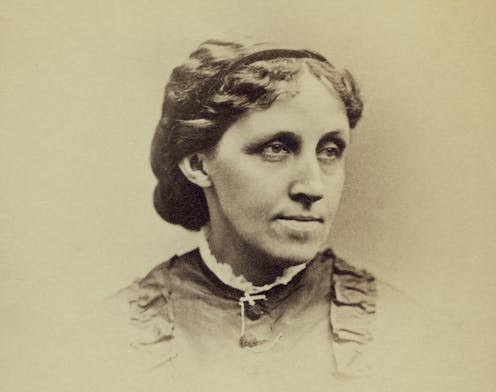
Before Louisa May Alcott published the bestselling “Little Women” in two volumes – the first in 1868, the second in 1869 – she wrote melodramatic thrillers, selling these short stories to magazines to bring in cash for her impoverished family.
On a cold November day in 2021, I was rereading Madeleine B. Stern’s introduction to her 780-page edition of “Louisa May Alcott’s Collected Thrillers.”
In the 1940s, Stern, with her research partner Leona Rostenberg, helped reveal that Alcott had written many of these sensational tales under the pseudonym A. M. Barnard.
But Stern wondered if any other stories written by Alcott were still out there.
For example, in “Little Women,” Jo March – the character who most closely resembles Alcott – also writes short stories to support her struggling family.
“‘A Phantom Hand’ put down a new carpet,” Alcott writes, “and the ‘Curse of the Coventrys’ proved the blessing … in the way of groceries and gowns.”
Stern points out that there’s a related reference in Alcott’s journals – “not to ‘A Phantom Hand’ but to ‘A Phantom Face,’ for which she earned $10 in 1859.”
“But,” Stern adds, “neither the ‘Phantom Hand’ nor the ‘Phantom Face’ has been tracked down.”
At the time, I was a graduate student working on my dissertation. I was on the hunt for pseudoscientific short stories, so the mention of Alcott’s missing tales piqued my interest.
Where was this phantom “Phantom” story? Could I find it?
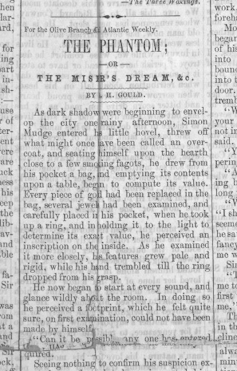
After searching digital databases, I came across one such story, called simply “The Phantom,” with the subtitle, “Or, The Miser’s Dream, &c.” It had been published in the Olive Branch in early 1860, months after Alcott listed having written “The Phantom” in her journals. But the byline under the story read E. or I. – I couldn’t quite make out the first initial – Gould, which wasn’t a known pseudonym of Alcott’s.
So I went to sleep. Sometime later I awoke with the thought that Gould might be Alcott. What if, along with her several known pseudonyms – A. M. Barnard, Tribulation Periwinkle and Flora Fairfield, among others – Alcott had yet another that simply hadn’t been identified yet?
I cannot say for certain that Gould is Alcott. But I’ve encountered enough circumstantial evidence to consider it likely Alcott wrote seven stories, five poems and one piece of nonfiction under that name.
More clues emerge
The publication dates of Gould’s stories – and the outlets where they appeared – certainly suggest Alcott’s authorship.
From the mid-1850s onward, Alcott regularly churned out stories, and yet the record leaves a noticeable gap between spring 1857 and late 1858. In one of Alcott’s letters from the period, she wrote to a friend asking if the magazine Olive Branch would be interested in more of her work. Years earlier, in 1852, Alcott had published “The Rival Painters” in that magazine. Until now, all scholars assumed it was her only story published in the Olive Branch.
In the course of my sleuthing, I found several other pieces that were written by Alcott or had likely been written by her, including a 1856 Saturday Evening Gazette piece called “The Painter’s Dream” and an anonymous Olive Branch story from 1857, “The Rival Painters: A Tale of Florence.”
The latter “Painters” was published in the exact period – and in the same magazine – as many of the Gould pieces. Several other outlets that published Gould also have connections to Alcott. For example, one of the Gould stories appears in the magazine Flag of Our Union, where Alcott later published under the Barnard pseudonym.
But to me, the clearest evidence connecting Gould to Alcott comes from the stories themselves. The name Alcott serves as the last name of the protagonists in two of Gould’s stories. Additionally, “The Wayside” – the name of one of Alcott’s homes – is the title of a nostalgic piece of nonfiction authored by Gould.

The stories also resemble Alcott’s early fiction in important ways. As I argue in one of my dissertation chapters, Alcott pioneered the “sensation” genre. These stories combined elements of sentimental tales with melodramatic thrillers. Instead of taking place in European castles and British landed estates, they were set in the types of places that would have been familiar to the emerging American middle class, such as doctors’ offices and insane asylums. Alcott’s stories show how tensions of gender and class can make those mundane spaces fraught with danger and possibility.
At the same time, there are signs that Gould might not be Alcott. Gould was a common name, especially around Boston. Alcott also kept lists of her stories, and only one of the Gould pieces – “The Phantom” – shows up on those long lists.
However, evidence suggests that the lists aren’t exhaustive – some stories appear on one list but not another – and Alcott refers to stories in her diaries that don’t appear on any lists.
Pseudonyms and guessing games
Why would an author like Alcott use pseudonyms anyway?
For one, Alcott was poor. So early in her career she wrote and published for money, and she might not have been particularly proud of everything she wrote. By disguising her name, Alcott could publish in less prestigious venues for a quick buck without worrying about tarnishing her literary reputation.
Even though she was poor, Alcott’s family had wealthy and cultured connections. Among them was Henry David Thoreau who, in “Walden,” disparaged the Olive Branch as one of the papers spreading “the gossip of Boston.” And while Alcott’s own mother often praised her writing, she did so only when the Alcott name was printed in more highly regarded venues, like The Atlantic.
Pseudonyms also allowed Alcott to write about topics she might not have felt comfortable attaching her name to. Many stories written under the Barnard pseudonym depict drug use, reverse gender roles and discuss class conflict in ways that were radical for the late 1850s.
A culture awash in authorial ambiguity
Are there any other Alcott stories that remain unidentified? I would say there almost certainly are. As to whether Alcott used any pseudonyms in addition to the ones that have been identified, that’s less likely but possible.
However, I also hope that the identification of Gould restarts a conversation about authorship, especially for literary figures of the past.
Alcott found herself awash in authorial ambiguity. Her first Olive Branch story, “The Rival Painters,” appeared next to a short essay by the wildly famous and pseudonymous Fanny Fern, who was a master at manipulating public perceptions.
After the blockbuster success of “Little Women,” Alcott published a novel, “A Modern Mephistopheles,” as part of the “No Name Series.” Released by the publishing house Roberts Brothers, the collection featured books written anonymously by famous writers. Readers would try to guess the real authors, but Alcott didn’t reveal she wrote the novel until a few months before her death.
Alcott was deeply embedded in a culture of unknown, and yet guessable, authorship. Anonymity liberated Alcott, Fern and other writers – particularly women – by allowing them to tackle risky topics. But anonymity and pseudonyms didn’t stop people from sleuthing, now or then. Readers delighted in trying to figure out an author’s possible masks, just like I’m doing now with Gould. And it wasn’t just readers: Editors and writers withheld information while at the same time leaving clues. Everyone got in on the fun of hidden identities.
I’ll keep gathering evidence that may either prove or disprove Alcott’s authorship of Gould’s stories. But if I never know, that’s fine with me.
Alcott herself loved acting, and she loved wearing masks, both literally on the stage and figuratively in print. In the spirit of the masquerade, the Gould pseudonym adds to the allure of mystery – and the joy of discovery.
Max Chapnick first presented this research at the American Literature Association Conference in 2022, where he recieved funding from the Louisa May Alcott Society of which he is also a member.
The Hardy Boys: Public Domain in 2023
This post is authored by Heidi Bowles, current student at the UC Davis School of Law and former research assistant at Ohio State University Libraries’ Copyright Services.
The first three novels of the popular children’s detective series The Hardy Boys (The Tower Treasure, The House on the Cliff, and The Secret of the Old Mill) entered the public domain on January 1, 2023, meaning that they are free from copyright protection in the United States. The Ohio State University’s Rare Books and Manuscripts Library has copies of the original 1927 editions of The Tower Treasure and The House on the Cliff.
The Hardy Boys was created by the Stratemeyer Syndicate and published by Grosset and Dunlap. The Syndicate was a book packaging company that produced many popular children’s series in the twentieth century, like Nancy Drew and The Rover Boys. To create so many books on a short timeframe, the Syndicate operated as a well-oiled machine that followed a standard process for creating a book: a Syndicate executive, often Edward Stratemeyer himself, produced a short outline of a story, which was provided to a contracted ghostwriter who then wrote it into a book for a flat fee. The book was then returned to a Syndicate executive for final edits before being sent to the publisher. When launching a new series, they would release three initial books to test whether or not there was a market for their idea. These first three test books for The Hardy Boys are now in the public domain.
In the early years of the series, Edward Stratemeyer provided the outlines to Leslie McFarlane, who wrote under the pseudonym Franklin W. Dixon. The first eleven books in the series were written by McFarlane, who also contributed to other Syndicate series under various pseudonyms. After Stratemeyer’s death in 1930, other Syndicate writers, including his daughter Harriet Stratemeyer Adams, contributed outlines to several uncredited ghostwriters writing as Franklin W. Dixon.
Copyright
The Copyright Act of 1909, which applies to works created before January 1, 1978, provided new works that followed proper formalities with a 28-year period of copyright protection with the option to renew the copyright for another 28-year period. Changes in the law (in the Copyright Act of 1976 and the 1998 Sonny Bono Copyright Term Extension Act (CTEA)) extended the second period, making the maximum copyright term for published works covered by the 1909 Copyright Act 95 years from the date of publication.
Under the terms of an agreement between the authors and Stratemeyer Syndicate, copyright in the works appears to have been transferred and then registered in the name of the publisher (Grosset and Dunlap). Under the agreement, actual writers of the series did not receive a share of the royalties for sales of the books.[1] Franklin W. Dixon (a pseudonym) was listed as the author in the copyright registrations for many of The Hardy Boys novels, rather than the actual writers.
Under the 1909 Copyright Act, a publisher who was assigned copyright could control the copyright for the initial term, but the author, if still living, could claim the copyright for the renewal term. If the author was not living at the time of renewal, the copyright in the renewal term could be claimed only by those designated under the law. Harriet Stratemeyer Adams, who took charge of the Syndicate after her father’s death, renewed the copyrights in 1955 and claimed them for the renewal term.
The Syndicate’s practices of hiring contract writers and publishing series under a pseudonym let them control their stories and their legacies. They were able to authorize many spinoffs, adaptations, and revisions. In the 1950s and 1960s, during the renewal copyright term, the Syndicate shortened and revised the original Hardy Boys series. Although they were based on the original public domain books, these revisions are still protected by copyright.
Releasing these revisions did not restart the copyright in the original books—as derivative works, the elements taken from the original books are not copyrightable, only the new creative elements in the revised versions. The revised wording, revised characterization, illustrations and other new elements are protected by a separate copyright that will last for 95 years after publication.
Similarly, characters and events from the revised version or later iterations of the series are still protected by copyright. In the 1927 Tower Treasure, Frank and Joe Hardy were sixteen and fifteen years old but they were eighteen and seventeen in 1959. Only the sixteen-year-old and fifteen-year-old brothers are public domain.
The later revisions also altered the sidekick characters. One snarky review explains:
All the same, the Hardy Boys’ gang was a model of diversity for its day. In addition to best pal Chet Morton (or as he’s referred to in the original books, “the fat youth”), there was strongman Biff Hooper and two bona fide ethnics—Phil Cohen, a brainy Jewish kid; and Tony Prito, who is so darned ethnic that his poor Italian-accented English is the subject of good-natured mirth in the 1927 version of “The Tower Treasure.” In the 1959 rewrite, the melting pot has done its work and only the ethnic names remain. Tony Prito becomes “a lively boy with a good sense of humor.” Phil Cohen is “a quiet, intelligent boy.”
Characters and their characterization are copyrightable elements of a story, so only the version of the characters as they appear in these three 1927 books are in the public domain. Later updates to the specific characters are still protected by copyright. The stereotypical versions of Tony Prito and Phil Cohen are in the public domain, but the homogenized versions are not. Anyone making an adaptation or using these characters should be careful to avoid using any later versions of the character to avoid copyright issues.
This does not mean that any adaptation has to include these characters as they exist in the 1927 books. They can be changed and updated; it is just important to make sure that any changes to the characters have not already been made in copyrighted materials. To take clothing as an example, an adaptation would not have to dress the brothers in their original 1920s clothing simply because that version is in the public domain. There would be no copyright issues with styling the brothers as punks with pink mohawks and leather jackets (assuming that no copyrighted version like this already exists). There might, however, be copyright issues with dressing them in sweaters and denim as they appear in the 1950s.
Public Domain
Now that these books are in the public domain, they can be freely copied, adapted, distributed, performed, and displayed without having to seek permission from a rightsholder, negotiating a license, or paying royalties. This means that they can be posted online so they are more easily available for researchers and general readers, and they can be adapted by creators.
Public domain children’s books are particularly valuable because they are more accessible to children who do not live near a library and cannot afford to buy their own books, and, as the Authors Alliance pointed out, there is a severe lack of children’s books in many non-English languages. Public domain books are easier and cheaper to translate into languages with fewer available books.
Public domain materials are also available to be updated to address past injustices. The original Hardy Boys books were filled with racist and sexist stereotypes, and other reflections of 1920’s white male middle-class prejudice.[2] These books have sentimental value for many, and their enduring popularity makes them important material for researchers. Although these books might not be the best option to give to children, it is important to preserve and understand the underlying values of a series that many remember fondly as a part of their childhoods.
The public domain is a valuable and essential part of the lifecycle of copyright that makes creative works available to be freely used and inspire new works. This year, many important and interesting works entered the public domain. A few other notable works include:
- Virginia Woolf’s To The Lighthouse
- Sinclair Lewis’s Elmer Gantry
- Langston Hughes’s Fine Clothes to the Jew
- Jerome Kern and Oscar Hammerstein’s Show Boat
- Georgia Douglas Johnson’s Plumes: A play in one act
- John Dewey’s The Public and Its Problems
Learn more about how Ohio State is celebrating the public domain at go.osu.edu/PublicDomainDay.
[1] For more about the history and business practices of the Stratemeyer Syndicate, see Carol Billman’s 1986 book, The Secret of the Stratemeyer Syndicate: Nancy Drew, The Hardy Boys, and the Million Dollar Fiction Factory (link to OSUL catalog).
[2] For an analysis of The Hardy Boys series, see Joe Arthur’s 1991 OSU dissertation, “Hardly Boys: An Analysis of Behaviors, Social Changes, and Class Awareness in the Old Text of the Hardy Boys Series.”
Endometriosis: It’s time to change the pattern of pain, stigma and barriers to diagnosis and treatment

Endometriosis is a debilitating disease that affects an estimated one million Canadians. It involves the overgrowth of endometrial tissue (the tissue that lines the uterus), which typically sheds during menstruation and regrows to support reproduction.
With endometriosis, the endometrial tissue grows excessively, both inside and outside of the uterus, which can cause pelvic pain, extreme menstrual cramping and non-menstrual cramping, as well as chronic fatigue and reduced fertility.
The Government of Canada recently announced more than $1.6 million for endometriosis patients and research, the largest single investment in endometriosis care in Canada for the last 20 years. This much-needed, long-awaited funding will go far to address the many challenges that endometriosis patients face, including struggling to get a diagnosis in the first place, dismissal of their symptoms, related stigma, and ineffective treatments.
Left untreated, endometriosis can affect the central nervous system, leaving patients at heightened risk of abnormal pain and chronic pain presentation, which too often negatively impacts their overall quality of life.
In fact, endometriosis patients often experience a reduced ability to participate in the activities of everyday life. Yolanda Kirkham, an obstetrician-gynecologist (OBGYN) from the University of Toronto, has reported that girls and young women are unable to attend school for a few days each month due to their symptoms, while others with the disease frequently miss work due to nausea and vomiting.

The unfortunate outcome for these patients is not just their reduced ability to participate in activities. It also means they experience significant losses in their economic productivity. Researchers have found that the average endometriosis patient in Canada loses around $3,400 in economic productivity per year.
Delayed diagnosis
One of the significant challenges faced by people with endometriosis is receiving a diagnosis. Patients experience an average delay of 5.4 years from the onset of symptoms to diagnosis. The symptoms are similar to other reproductive health issues (such as polycystic ovary syndrome) or severe period pain, which can be confusing for non-specialist health-care professionals.
Research with endometriosis patients has shown that most cases of endometriosis are not diagnosed by primary care providers, but by specialists — namely OBGYNs to whom they are referred. Taken together with long waiting lists for specialists, the barriers to diagnosis are significant.
Another barrier is that women often have difficulty convincing care providers their pain is real and a cause of concern. In a recent research project, one of us (Sarah Seabrook) examined 70 publicly available accounts of people experiencing endometriosis, including quotes printed in newspapers, as well as from the narratives published by endometriosis not-for-profit EndoAct.
Patients described being dismissed, that their pain was “just muscle pain,” “all women go through this,” and “this is the way cycles are for women,” and to live with it.
This dismissal of pain is particularly troublesome because people don’t often share their menstrual experiences and may be unable to differentiate between normal and abnormal menstrual experiences. In an article published by CBC News in 2021, a woman with endometriosis reported that the first few times she had her period, she was hospitalized for severe pain, but because this was her initial experience of menstruation, “she thought the pain related to her period was normal.”
Lack of effective treatments
Once endometriosis is diagnosed, there are significant barriers to receiving effective treatment. The first line of treatment is typically hormonal birth control, which does nothing to address the growth of endometrial tissue, although for some people it can help with controlling menstrual pain. The same is true of anti-inflammatories and painkillers, which can reduce pain, but do little for the growth of endometrial tissue.
When things are more severe, patients might be given surgical options such as tissue excision (removing the entire endometriosis lesion) or ablation (burning off the surface of the endometriosis lesion). However, these procedures are rarely curative — the excess endometrial tissue grows back in a lot of cases. As a final resort, some patients undergo a hysterectomy. For the most part, endometriosis care is focused on either temporarily reducing pain, or temporarily controlling the growth of tissue.
The lack of effective treatment options is tied to an ongoing failure to understand endometriosis, its underlying causes and effects. Leading Canadian experts have been calling for the improved understanding of endometriosis care and its treatment options, and advocates have been mobilizing for increased funding to understand, diagnose and treat endometriosis in Canada.
To improve outcomes, endometriosis patients need more research, more options and more attention to be paid to the disease. The newly announced federal investment in endometriosis research and care by the federal government is a good first step — although continued funding and support will be needed to address the continued, far-reaching effects of endometriosis in Canada.
Alana Cattapan receives funding from the Social Sciences and Humanities Research Council of Canada and the Canadian Institutes of Health Research.
Sarah Seabrook does not work for, consult, own shares in or receive funding from any company or organisation that would benefit from this article, and has disclosed no relevant affiliations beyond their academic appointment.
Why Franklin, Washington and Lincoln considered American democracy an 'experiment' -- and were unsure if it would survive
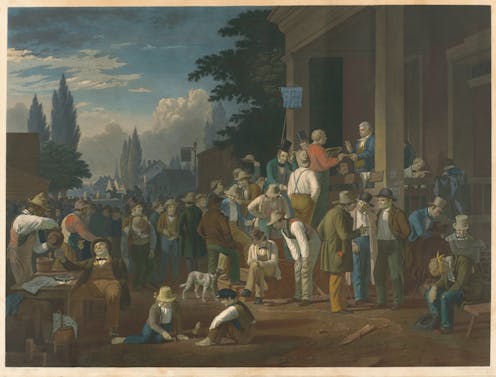
From the time of the founding era to the present day, one of the more common things said about American democracy is that it is an “experiment.”
Most people can readily intuit what the term is meant to convey, but it is still a phrase that is bandied about more often than it is explained or analyzed.
Is American democracy an “experiment” in the bubbling-beakers-in-a-laboratory sense of the word? If so, what is the experiment attempting to prove, and how will we know if and when it has succeeded?
Establishing, then keeping, the republic
To the extent you can generalize about such a diverse group, the founders meant two things, I would argue, by calling self-government an “experiment.”
First, they saw their work as an experimental attempt to apply principles derived from science and the study of history to the management of political relations. As the founder John Jay explained to a New York grand jury in 1777, Americans, acting under “the guidance of reason and experience,” were among “the first people whom heaven has favored with an opportunity of deliberating upon, and choosing the forms of government under which they should live.”
Alongside this optimistic, Enlightenment-inspired understanding of the democratic experiment, however, was another that was decidedly more pessimistic.
Their work, the founders believed, was also an experiment because, as everyone who had read their Aristotle and Cicero and studied ancient history knew, republics – in which political power rests with the people and their representatives – and democracies were historically rare and acutely susceptible to subversion. That subversion came both from within – from decadence, the sapping of public virtue and demagoguery – as well as from monarchies and other enemies abroad.
When asked whether the federal constitution of 1787 established a monarchy or a republic, Benjamin Franklin is famously said to have answered: “A republic, if you can keep it.” His point was that establishing a republic on paper was easy and preserving it the hard part.
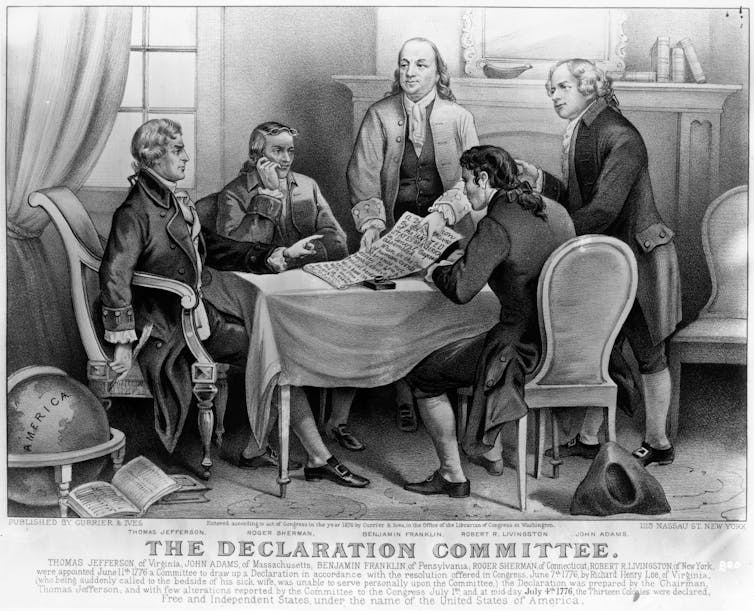
Optimism and pessimism
The term “experiment” does not appear in any of the nation’s founding documents, but it has nevertheless enjoyed a privileged place in public political rhetoric.
George Washington, in his first inaugural address, described the “republican model of government” as an “experiment entrusted to the hands of the American people.”
Gradually, presidents began to talk less of a democratic experiment whose success was still in doubt than about one whose viability had been proven by the passage of time.
Andrew Jackson, for one, in his 1837 farewell address felt justified in proclaiming, “Our Constitution is no longer a doubtful experiment, and at the end of nearly half a century we find that it has preserved unimpaired the liberties of the people.”
Such statements of guarded optimism about the American experiment’s accomplishments, however, existed alongside persistent expressions of concern about its health and prospects.
In the period before the Civil War, despite participating in what in hindsight was a healthy, two-party system, politicians were forever proclaiming the end of the republic and casting opponents as threats to democracy. Most of those fears can be written off as hyperbole or attempts to demonize rivals. Some, of course, were sparked by genuine challenges to democratic institutions.
The attempt of Southern states to dissolve the Union represented one such occasion. In a July 4, 1861, address to Congress, Abraham Lincoln quite rightly saw the crisis as a grave trial for the democratic experiment to survive.
“Our popular Government has often been called an experiment,” Lincoln observed. “Two points in it our people have already settled – the successful establishing and the successful administering of it. One still remains – its successful maintenance against a formidable internal attempt to overthrow it.”
Vigilance required

If you tried to quantify references to the democratic “experiment” throughout American history, you would find, I suspect, more pessimistic than optimistic invocations, more fears that the experiment is at imminent risk of failing than standpat complacency that it has succeeded.
Consider, for example, the popularity of such recent tomes as “How Democracies Die,” by political scientists Steven Levitsky and Daniel Ziblatt, and “Twilight of Democracy,” by journalist and historian Anne Applebaum. Why this persistence of pessimism? Historians of the United States have long noted the popularity since the time of the Puritans of so-called “Jeremiads” and “declension narratives” – or, to put it more colloquially, nostalgia for the good old days and the belief that society is going to hell in a handbasket.
The human-made nature of our institutions has always been a source of both hope and anxiety. Hope that America could break the shackles of old-world oppression and make the world anew; anxiety that the improvisational nature of democracy leaves it vulnerable to anarchy and subversion.
American democracy has faced genuine, sometimes existential threats. Though its attribution to Thomas Jefferson is apparently apocryphal, the adage that the price of liberty is eternal vigilance is justly celebrated.
The hard truth is that the “experiment” of American democracy will never be finished so long as the promise of equality and liberty for all remains anywhere unfulfilled.
The temptation to give in to despair or paranoia in the face of the experiment’s open-endedness is understandable. But fears about its fragility should be tempered with a recognition that democracy’s essential and demonstrated malleability – its capacity for adaptation, improvement and expanding inclusivity – can be and has historically been a source of strength and resilience as well as vulnerability.
Thomas Coens does not work for, consult, own shares in or receive funding from any company or organization that would benefit from this article, and has disclosed no relevant affiliations beyond their academic appointment.
Why iconic trees are so important to us – and how replacing those that fall is often complicated

An ancient kola tree has been cut down in southern Ghana. Local tradition held that the tree had grown on the spot where spiritual leader Komfo Anokye had spat a kola nut onto the ground three centuries previously.
Anokye was a fetish priest – a person believed to act as a mediator between the living and the spirit world – and the tree that took his name was reputedly able to cure ailments and lift curses.
These legends, and its location on a major road, turned the Komfo Anokye tree into a tourist attraction and a symbol of ancestral roots. Its loss is historically, culturally and ecologically significant.
The felling of the iconic tree prompted an outpouring of anger and grief, and a desire to repair the damage done. But what is it about the loss of a tree that provokes such an emotional response? Why is it that single trees are so important to us? And why might our instinct to repair the damage by planting a new tree prove unexpectedly complicated?
Tree felling as an emotive issue
The felled tree, and the outpouring of emotion that followed, is one of several such high-profile instances. In late October 2023, the decision was made to cut down the 550-year-old Darwin’s Oak in Shrewsbury. The Woodland Trust described the felling as a “death sentence”.
The felling of the Sycamore Gap tree in September 2023, which was located next to Hadrian’s Wall in Northumberland, was described in similarly emotional language.
The deliberate cutting down of trees is highly emotive because they are central to how we perceive ourselves within our environment. Trees are living archives, recording the past of our planet and our own personal histories.
Individual trees are steeped in storytelling and symbolism. Some cultures believe that the spirits of the ancients and family members reside within Africa’s climate-vulnerable baobab. And the Ankerwycke yew at Runnymede in Surrey is described as the last surviving witness to the sealing of the Magna Carta in 1215.
The Sycamore Gap tree was also an iconic image. Its fall prompted local and global reaction on such a scale that we might be forgiven for concluding that felling one tree elicits a more visceral reaction than the destruction of entire rainforests.
While Sycamore Gap was grabbing the headlines, the latest state of nature report showed the UK to be one of the most nature-depleted countries in the world. This juxtaposition exemplifies the different ways in which people ascribe value to nature.
Our research from 2021 explored the different ways that people prioritise their relationships with nature. Some protect nature for human benefit and others seek to protect nature for its own sake. At the same time, some people prioritise the conservation of species and ecosystems, while others focus on the wellbeing of individual specimens.
Iconic trees are a prime example of this contrast. The action we take to protect iconic trees, or to replace those that fall, may satisfy the moral imperative to “do something”. But it is often energised by a greater concern for individual organisms than for the need to protect the wider environment.
Replacing iconic trees
Tree planting has political capital as a way to tackle climate change. But rushing to replace lost nature on our own terms and without effective management can lead to poor outcomes.
Neither a single sapling, nor many, will directly replace the unique ecosystem of a 300-year-old tree – at least not for another 300 years. If we treat nature as easily replaceable, we embrace the “quick fix” and ignore the impact of human actions on ecological succession and the vast complexity of the ecological system.
Ecological succession is the natural and never ending process of change in an ecosystem. It is what allows a healthy woodland to regenerate itself, for example, after forest fires.
Human intervention can disturb this process. The planting of single species or non-native trees can undermine the ecosystem, accelerate soil erosion and increase vulnerability to pests and disease.
The felled tree at Sycamore Gap was removed and stored pending a decision on what to do with it. But, similar acts of removal elsewhere in the wild can disrupt ecosystems too. Dead trees are a vital component of any woodland as they recycle nutrients, support the growth of fungi, and provide a home for a diverse array of birds, insects and mammals.
The tree at Sycamore Gap stood in isolation, but the loss of a single tree is still not without consequence. The complexities inherent in replacing the ecological value of lost trees must not blind us to their wider and equally important cultural significance. In the words of the British-American poet, W.H. Auden: “The trees encountered on a country stroll, reveal a lot about a country’s soul.”
Conservation debates should be about more than economic or functional human benefits. They should integrate history, culture and values into our relationship with the natural world.

Don’t have time to read about climate change as much as you’d like?
Get a weekly roundup in your inbox instead. Every Wednesday, The Conversation’s environment editor writes Imagine, a short email that goes a little deeper into just one climate issue. Join the 20,000+ readers who’ve subscribed so far.
Les auteurs ne travaillent pas, ne conseillent pas, ne possèdent pas de parts, ne reçoivent pas de fonds d'une organisation qui pourrait tirer profit de cet article, et n'ont déclaré aucune autre affiliation que leur organisme de recherche.
Rats are more human than you think – and they certainly like being around us

Rats have a somewhat unfortunate tendency to enjoy living where people live. That’s how a biologist tried to explain people’s hatred for the rodents in a television news feature about rats gnawing electrical cables in parked cars in the southern Swedish town of Malmö.
The brown rat, Rattus norvegicus, is one of the species best adapted to modern society. These rats have followed humans around the world to become one of the most abundant mammals, spreading from their native distribution in northern China and Mongolia and reaching Europe in the 1500s, possibly even earlier. Black rats, however, arrived in Europe as early as the 1st century AD.
Today almost all wild brown rats are synanthropic, meaning they live in close association with humans, eating our leftovers and using human structures for shelter. The relationship between rats and humans is one of commensalism, a word derived from the Latin term “commensal”, meaning “eating at the same table”.
Throughout the centuries, rats have been cast as humanity’s dark shadow. Rats have had an enormous impact on human civilisation, not least through the spread of diseases. They have long been associated with dirt, death and destruction. In medieval Europe people loathed rats for their so-called brutishness, seemingly limitless sexual appetite and fecundity. But their huge numbers and adaptability mirrors humans’ evolutionary success.
They have spread with wars and European imperialism to colonised territories in the Americas as well as Africa and Australia. Rats thrive in the trenches of modern warfare even today.
A social and empathetic animal
Real rats are far from the despicable creatures they often are made out to be. Several studies have shown that rats have powerful empathy.
These animals can share the emotional state of others, which in psychology is called emotional contagion. Research has shown that when a rat sees another rat in distress, the neural structures activated in that rat’s brain closely resembles those activated in humans brains when feeling empathy for pain of others.
One experiment showed that rats will release a fellow rat from an unpleasant cage even if they are not rewarded for it. And if given chocolate treats afterwards, the free rat would usually save at least one treat for the former captive.
This selfless behaviour comes from rats’ socially complex lives in family groups of multiple generations. They form lifelong bonds with other rats and share socially learned skills, such as foraging techniques, across generations. This means rats have a form of culture.
A study from 2023 even showed that rats can imagine places and things that aren’t in front of them at the time. In experiments rats were shown to navigate a space in their thoughts, that they have previously explored. As in the studies of empathy, researchers demonstrated this by comparing the regions in the rat’s brains that were activated to those that are activated when humans think about navigating their way through places they have visited.
This ability to imagine also suggests that rats have a sense of past and future.
Living and dying with rats
With this in mind, human ways of dealing with rats seem cruel. The most common chemical method for rat control is anticoagulants, which cause fatal internal bleeding one to two weeks after a rat eats the poison. Since rats are both socially intelligent and cautious, they prefer to sample unfamiliar food and then wait to see if it makes them or other rats sick.
It’s called poison shyness. With anticoagulants however, the time between consumption of the bait and the rat dying is so long that they don’t usually associate it with their feeding habits.
The human motivation for learning about rats has often been the desire to kill them. The foremost experts in wild rat behaviour are their exterminators. And yet, current methods for controlling wild rat populations are not very effective.
Some rats have developed resistance to the poisons and are able to eat it and survive. Trapping them is notoriously difficult, and they often recolonise the territory from which they have been removed.
Global urbanisation is probably only going to bring humans into closer contact with rats, and killing rats the way it is done today isn’t ethical.

Instead, we should consider other strategies, like the ones explored by the Urban Rat Project at the University of Helsinki. Here researchers from different disciplines are trying to get a deeper understanding of conflicts between rats and humans. They are studying both species and their interactions, in hope of a future with less bloody human-rat relations. The project has spotted that places in urban areas where people feed birds tend to attract rats as well – which people then try to eradicate using poison or traps.
Research has also suggested that with increased knowledge about rats and their behaviour people tend to develop a more positive attitude towards them. So more knowledge of wild rats’ social behaviour is needed. And humans need to manage their own behaviour to avoid conflict with rats.
A good place to start would be reducing food waste and stop leaving leftovers out unsecured. Less rats around human food sources, for example, and more knowledge about their behaviour would mean a lower risk of diseases spreading from rats to humans, as well as from humans to rats.
Humanity’s future is with the rat, a social and empathetic animal. So it’s time we understood our shadows.
Tobias Linné does not work for, consult, own shares in or receive funding from any company or organisation that would benefit from this article, and has disclosed no relevant affiliations beyond their academic appointment.
Being child-free has been deemed 'selfish' for decades – the history of this misconception explained

Choosing to be child-free is more common than ever before in some countries, including the US. Many people see not having children an ethical and ecological choice, made to protect the environment, people and other species. Being child-free is about being “green”. Consequently, more positive discourses around childlessness are emerging.
But this was not always the case. In societies that encourage an increased birthrate, motherhood is often presented as natural and caring. Meanwhile, women without children are often described as biological failures, or as deviant. For example, when visible in popular culture – they are often not represented at all – women without children are either presented as animal-lovers like the “crazy cat lady” or animal-killers, like Cruella de Vil. In these examples, the focus on animal represents their supposed inability to care for humans (their species), their “unnaturalness”.
In the 19th century, women without children were already being described as selfish and unnatural. The natural world was conversely used to describe fertile women, who were often compared to flowers in bloom in literature.
Should I have children? The pieces in this series will help you answer this tough question – exploring fertility, climate change, the cost of living and social pressure. We’ll keep the discussion going at a live event in London on November 30. Click here for more information and tickets.
The association of women with plants and fertility is an ancient one, found particularly in agricultural pagan figures. Demeter, the ancient Greek goddess of the harvest, for example, was the goddess of grains, but also of marriage and fertility.
Many expressions still link women’s reproductive systems and flowers. In French, the flower is a metaphor for a virgin sexual organ. To avoir ses fleurs (have your flowers) is an expression for having periods, and being une jeune fille en fleur (a young woman in flower) means that the young woman is ready for marriage – and therefore reproduction.
Women themselves are also compared to flowers: in English, both “pretty flower” and “English rose” describe attractive young women. Reducing women to flowers, through these comparisons, is not only misogynistic, but reinforces the social pressure to produce children “on time”. Timing is important in these comparisons, as flowers fade quickly.
Being child-free in the 19th century
But what about women without children, those flowers that will not produce seeds? My research into literature and paintings from the second half of the 19th century has shown that they were often represented as monstrous horticultural hybrids.
At the time, “hybrid flowers” – which were often sterile – became the preferred metaphor to describe sexually active women who were either unable or refused to bear children. In France, having and raising children was seen as a woman’s natural and civic duty for the nation. Conversely, women who were sexually active but without children were often seen as unnatural and dangerous.
Comparisons that described women as flowers were historically about fertility. How was it then that flowers became a metaphor for sterility at the end of the 19th century?
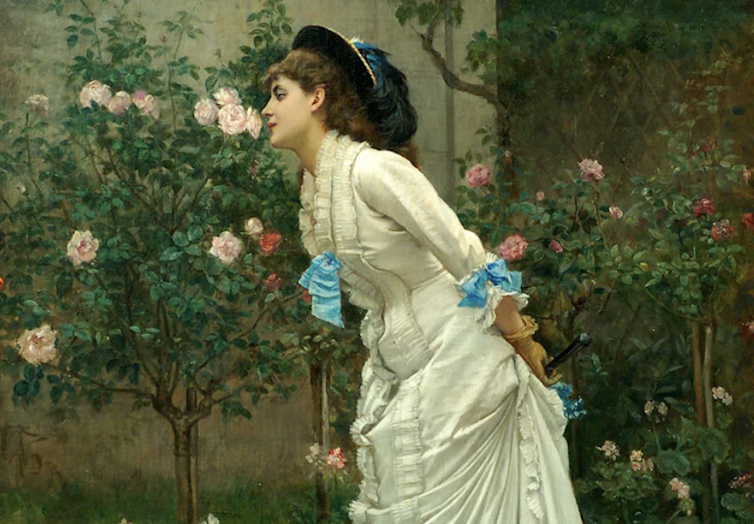
The emphasis on flowers as sexual organs and as a metaphor for women’s sexuality appears to have been used more often after the Swedish botanist Carl Linnaeus openly discussed the sexuality of plants with anthropomorphic language at the end of the 18th century.
It is important to note that, for a long time, if men knew at all that flowers were sexual organs, they believed they were unisexual and feminine. They did not believe that both male and female organs were involved in the production of fruits.
Once the sexual nature of plants had been established, the nature of the floral metaphor changed and the innocence of the flower was lost. Flowers progressively became the symbol of a young lady with an emerging sexuality or who was waiting to “bear fruit”.
Horticultural hybrids
During the second empire in France (1852-1870) and the beginning of the Third Republic (1870-1840), horticultural hybrids were extremely popular.
Horticulturists developed large plants and flowers such as cattleya, hibiscus, nidularium which often looked like enlarged genitals (natural plants are often a lot smaller and less colourful). These hybrids made the sexual analogy even more obvious.
By the end of the 19th century, the artificial hybrids became used for describing, indirectly, near-pornographic scenes. Here is an example from The Kill (1895), a famous novel by Émile Zola. Instead of describing the characters making love, he describes the plants:
As their glances penetrated into the corners of the hothouse, the darkness became filled with a more furious debauch of leaves and stalks; they could not distinguish on the terraces between the marantas, soft as velvet, the gloxinias, purple-belled, the dracoenas, like blades of old lacquer; it was a great dance of living plants pursuing one another with unsatisfied fervour.
Many of the hybrids being created at this time were sterile. They therefore became a metaphor for “unproductive” sexuality. Because they were man-made, they could be seen as a perversion of the laws of nature. Comparing women to those hybrids was a way to criticise what was deemed the artificiality of their infertility, or decision not to have children.
Fertile, childbearing women were frequently compared to natural, more classic flowers such as roses or lilies.
At the time, France was obsessed with its low birth rate. Many politicians believed it explained why France had lost the war against Prussia (1870-1871). Childless women were therefore also seen as bad citizens.
Through their comparisons with hybrid, infertile flowers, women who could not or choose not to reproduce were deemed un-French, undesirable and, in some ways, monstruous.
Understanding how women are associated with nature and very often compared to flowers is essential to understanding how being childless continues to be demonised in contemporary society. As contemporary art, culture and the very language we use demonstrates, child-free women are still often described as “unnatural” or biologically deviant.

Looking for something good? Cut through the noise with a carefully curated selection of the latest releases, live events and exhibitions, straight to your inbox every fortnight, on Fridays. Sign up here.
Aude Campmas is affiliated with: I am a volunteer for Portsmouth Abuse and Rape Counselling Service.
Why all civilian lives matter equally, according to a military ethicist

Some commentators have criticized Israel for causing what is claimed to be disproportionate harm to civilians in its military response to Hamas’ Oct. 7, 2023, attack.
Others have defended Israel’s actions, claiming that such force – and the risk to civilians involved – is necessary to eliminate Hamas, which some Israelis believe poses an existential threat to Israel.
As of Nov. 25, according to health officials in the Gaza Strip, more than 14,000 Palestinians have been killed, the majority of whom are women and children.
But one of the arguments given by defenders of Israel’s actions is that, tragic though these deaths are, the harm inflicted on civilians is proportionate because it is outweighed by the importance of destroying Hamas.
But what does “proportionate” mean in the context of civilian deaths? And how should we assess Israel’s claims of proportionality against critics who argue that Israel’s actions have caused disproportionate harm to civilians? As a scholar of war crimes and military ethics, I argue that to assess these claims requires careful thought about what it really means to value civilian lives. If all civilian lives are morally equal, as international law holds, then the lives of civilians on both sides of a conflict should be treated with the same degree of respect.
Why targeting civilians is wrong
International humanitarian law, or IHL, prohibits direct attacks on noncombatants – a category that includes civilians as well as wounded and surrendered soldiers. IHL also prohibits direct attacks on civilian objects such as schools, religious centers and hospitals and other civilian infrastructure.
However, because it is impossible to avoid all harm to civilians in a war zone, IHL permits attacks on military targets that are likely to cause harm to civilians if two conditions are met: First, the foreseeable harm to civilians must be proportionate to the military advantage sought by the attack. And second, the choice of tactics and weapons – what is referred to in IHL as the “means and methods” – must also aim to minimize risk to civilians, even if it means putting more soldiers in harm’s way.
The prohibitions on directly targeting civilians and exposing civilians to disproportionate risk of harm exist because, under IHL, civilians have protected status as long as they take “no active part in the hostilities.” This means that, as stated in the Geneva Conventions – the set of international treaties governing the conduct of armed conflict – all civilians must be “treated humanely, without any adverse distinction founded on race, color, religion or faith, sex, birth or wealth, or any other similar criteria.”
Directly targeting civilians or exposing them to disproportionate harm is therefore wrong for the same reasons that it is wrong to kill or harm innocent people in peacetime. People who pose no threat to others deserve respect and protection from violence regardless of their nationality or group identity. To violate that respect in war is not only a war crime but a moral crime, which is why Hamas’ massacre of at least 1,200 Israeli citizens and the taking of 240 hostages is rightly condemned as an atrocity.

How should the lives of innocent people be weighed against important military objectives?
Proportionality and moral assessment
The condemnation of Hamas’ crimes is based on the same moral principle as the laws that protect noncombatants in war: All innocent people deserve protection.
However, scholars and legal experts disagree about how the legal framework laid out in the Geneva Conventions should be applied in war zones.
For example, in 1987 the International Committee of the Red Cross argued that the definition of “military advantage” – the advantage against which potential civilian harm must be weighed – should only include “ground gained” and “annihilating or weakening the enemy armed forces.”
But the 2016 U.S. Department of Defense Law of War Manual claimed that “military advantage” should also include other goals such as “diverting enemy forces’ resources and attention.”
There is also disagreement about what counts as “civilian harm.” For example, scholar Emanuela-Chiara Gillard argues that “civilian harm” should include psychological and physical harms; legal expert Dr. Beth Van Schaack argues that long-term harms should also be considered.
In short, there are no easy answers to questions about how to weigh harms against civilians against the value of military objectives. But while answers are difficult, there is a different way to frame this question: What does it mean – not just legally, but morally – to treat all civilian lives as equal, as the law requires?
As scholar Matthew Talbert and I argue, the first step in answering this question is to ask what a military force would accept if it were “their” civilians who were at risk of harm from military action.
That is the standard we should apply when assessing potential military actions that threaten harm to enemy civilians. We call this standard the “principle of the moral equality of noncombatants.” For example, Israel argued that its attack on Shifa hospital was justified because, it claimed, Hamas was hiding a command base and weapons under the hospital.
The hospital, which was running low on fuel, food and water, housed patients, including premature babies, and civilians seeking refuge from the conflict. According to footage shown in news reports, the attack left the hospital seriously damaged, filled with debris and lacking essential supplies for the remaining patients, who include the elderly and infirm.
Israel has released footage supporting its claim that there was a Hamas command center under the hospital. Does that mean Israel’s attack on the hospital meets the requirements of proportionality? In other words, was the harm to civilians caused by the attack – including the ongoing harm resulting from the loss of a major hospital – proportionate to the military value of destroying a Hamas command base?
In applying the principle Talbert and I proposed in our paper, the question would be phrased as follows: If Hamas was hiding a control base under an Israeli hospital and it was Israeli civilians at risk, would Israel think that attacking the hospital would be justified? If the answer is “no,” then the attack against Shifa hospital is also not justified.
This is because if the risk to Israeli lives outweighs the benefits of capturing a Hamas command base, then the risk to Palestinian lives should be given the same weight and lead to the same conclusion. Under IHL, all civilians are legally entitled to the same protection, regardless of their nationality.
Taking civilian lives seriously
Unfortunately, the debate about proportionality in the conflict between Israel and Palestine is only the latest of many debates about proportionality and civilian deaths in war zones.
For example, since 2001, the United States’ drone program has killed at least 22,000 civilians in Afghanistan, Iraq, Syria, Pakistan and elsewhere. A New York Times report on these deaths found multiple instances of “flawed intelligence,” cover-ups and cases of mistaken identity. Despite this record, civilians deaths still occur.
Using the principle of the moral equality of noncombatants to assess this track record would reveal whether the U.S. military is taking sufficient care to avoid harm to civilians. If the U.S. military would not accept these deaths – and the policies and practices that contribute to them – if U.S. civilians were at risk, then these deaths are unjustified.
This would mean that the drone program must change in order to treat civilians in Syria, Pakistan and elsewhere with the respect to which they are legally and morally entitled. This example illustrates that to meet the standards of IHL and the moral principles that underlie those standards, military forces must apply the principle of the moral equality of noncombatants. There is no legal or moral justification, I argue, for treating some civilians lives as less important than others.
This is a demanding principle. Applying it would be difficult - military and political leaders would have to accept that there might be military objectives that are not important enough to justify risk to civilian lives. And it would require acknowledging that some military objectives might be so important that even harm to “their” civilians might be justified.
But one of the functions of IHL is to “limit the suffering and damage caused by armed conflict.” This principle reflects the moral and legal status of civilians in IHL and could lead to greater respect for and protection of all civilians during conflict.
Jessica Wolfendale does not work for, consult, own shares in or receive funding from any company or organization that would benefit from this article, and has disclosed no relevant affiliations beyond their academic appointment.
PFAS forever chemicals found in English drinking water – why are they everywhere and what are the risks?

PFAS chemicals (per-and poly fluoroalkyl substances), also known as forever chemicals, are rarely out of the news at the moment. The latest concern about this chemical group is their presence in drinking water in England.
The Royal Society of Chemistry found that the UK’s drinking water standard is not stringent enough to protect us against the dangerous health effects of PFAS. The health risks include links to cancer and fertility problems.
But PFAS are a problem that is not going away anytime soon. Even if we stopped using them in products today, there are already huge amounts of them in the environment and some types of PFAS simply do not degrade. Our research has even found growing evidence of these chemicals in some of the most remote places on Earth, including the Antarctic.
To make matters worse, the PFAS chemicals that do degrade often break down into the more recalcitrant PFAS types, which then cycle around the environment endlessly.
What are PFAS?
Media coverage of the problem can be hard to follow because the PFAS group includes more than 5,000 different chemical substances.
It used to be common to read stories about poly- /perfluoro compounds (PFCs) and poly- /perfluoro alkyl acids (PFAs) rather than PFAS. Even now it is not uncommon to see products like outdoor clothing labelled as PFC free.
But a lot of PFCs are non-toxic and include a lot of widely used medical drugs. PFCs mean drugs with a carbon-fluorine bond, which is not a problem in itself. PFAS are a sub group of PFCs and they are toxic and extremely difficult to break down.
PFAs are a sub-group of PFAS chemicals. Over the last few years research has increasingly highlighted problems with the wider PFAS group than just PFAs. PFAS can be broadly split into two groups: fluoropolymers and non-polymers.
Fluoropolymers
The most well-known fluoropolymer is polytetrafluoroethylene (PTFE) with its trademark name Teflon, first produced by Dupont in the 1940s. PTFE is the non-stick coating to cookware. Its stability to high temperatures, non-reactivity and low friction properties makes it ideal for this application. We can ingest flakes of the polymer, but it is not absorbed by the body so just passes through us.
PTFE film is also used in some types of waterproof, breathable outdoor clothing. The micropores allow the passage of water vapour (from sweat for example) but prevent water droplets seeping through, keeping the wearer dry.
Other fluoropolymers include polyvinylidene fluoride (PVDF) used in sensors and batteries because of its ability to hold an electrical charge. While fluoropolymers are not considered toxic, their production relies on large quantities of other toxic chemicals, like non-polymers. They are better for us because the end product doesn’t bring us into direct contact with non-polymers, but bad news for the environment as that is where the non-polymers will probably end up.
Non-polymers
The non-polymer group has by far the biggest number of substances and their use is myriad – including in food packaging, cosmetics, medical applications, fabric coatings and electronics.
This group also includes refrigerant and cleaning solvents (replacement chemicals to the infamous CFCs banned to protect the ozone). They have high water and oil repellency and chemical stability. For industrial uses chemicals must be stable so that they do their job without reacting or breaking down. If you bought a cosmetic and it lost its colour or wouldn’t spread after a few days, for example, that wouldn’t be good.
Non-polymers also have good thermal stability. This makes it very useful for making food packaging such as pizza boxes and popcorn wrapping.

They are used in a lot of cosmetic products and toiletries because they make the product smoother, water resistant and easier to apply.
They have an eight-carbon chain (C8) with acidic heads. The longer chain length provides better stability and less friction which means they are useful as processing aids in polymer manufacture.
Since 2000, industry has moved away from C8 chemistry and shifted towards shorter chain length chemicals because of concerns over toxicity of the longer-chain compounds and their harm to the environment.
The shorter chain length does help them break down faster and makes them less toxic. However they don’t perform as well as the longer chain chemicals. So manufacturers use more of them in products and more of them get into the environment.
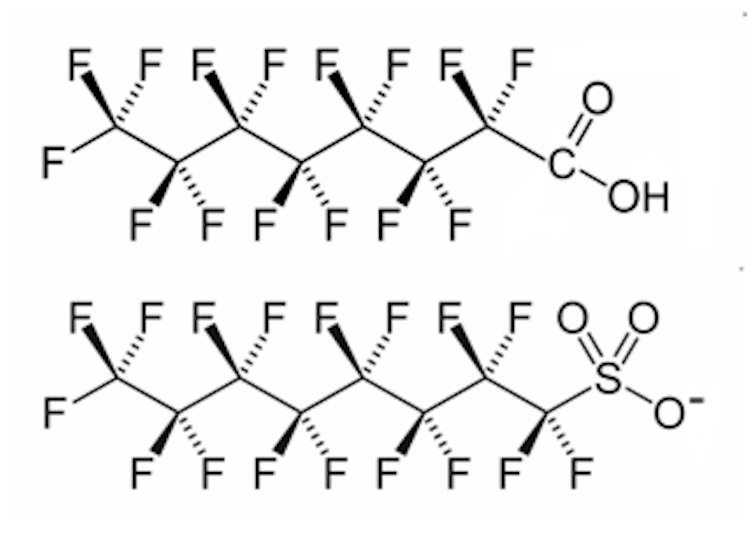
Toxic effects
The widespread of these chemical groups comes at a cost. PFAS enter the environment through the everyday use and disposal of products that contain them. Emissions from fluoropolymer manufacturing sites is another source.
Domestic and commercial wastewater contains PFAS, which is released into rivers and ocean currents and into remote parts of the planet as evidenced by my team’s recent work investigating high levels of PFAS in Arctic sea ice.
Humans are typically exposed to these chemicals through drinking water, food and household dust. They are a problem for our health because these chemicals have an acid head which tends to interact with and bind to protein molecules in blood. This has knock-on effects on health.
There is strong evidence to demonstrate that exposure to specific PFAS is linked with liver disease, cancer and damages people’s reproductive systems and children’s development. Another area of concern is repression of the immune system and lowered response to vaccines.
Many other countries such as the US and Denmark have revised their drinking water standards. It’s time UK drinking water standards caught up.
Crispin Halsall is a Professor of Environmental Organic Chemistry and receives funding from the Natural Environment Research Council (NERC) for his work on PFAS
Santos, now booted from the House, got elected as a master of duplicity -- here's how it worked
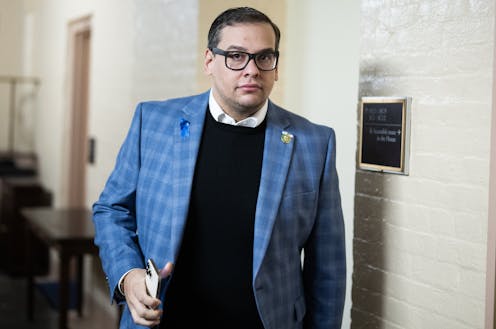
U.S. Rep. George Santos, a Republican from New York, was expelled on Dec. 1, 2023 from Congress for doing what most people think all politicians do all the time: lying.
Santos lied about his religion, marital status, business background, grandparents, college, high school, sports-playing, income and campaign donation expenditures.
Santos’ fellow members of Congress – a professional class stereotypically considered by the public to be littered with serial liars – apparently consider Santos peerless and are kicking him out of their midst on a 311-114 vote, with two members voting present.
How could a politician engage in such large-scale deception and get elected? What could stop it from happening again, as politicians seem to be growing more unapologetically deceptive while evading voters’ scrutiny?
Santos’ success demonstrates a mastery of something more than just pathological lying. He managed to campaign in a district close to the media microscope of New York City, in one of the richest districts in the state, and get elected and stay in office for a year, despite making a mockery of any semblance of honesty.
I am a scholar of political deception. Experiments I conducted have revealed how the trustworthiness of politicians is judged almost entirely from perceptions of their demeanor, not the words they utter.
Misleading with a smile
I have found that voters are drawn in by politicians’ demeanor cues, which are forms of body language and nonverbal communication that signal honesty or dishonesty and yet have no relationship to actual honesty. For example, looking nervous and fidgety or appearing confident and composed are demeanor cues, which give impressions of a politician’s sincerity and believability. Someone’s demeanor cues might signal that they are trustworthy when they’re actually lying, or could signal lying in someone who is actually telling the truth.
The most authoritative index of demeanor cues that affect people’s perceptions of honesty and deception was developed by Tim Levine, a professor of communication at the University of Alabama, Birmingham. Demeanor cues that convey sincerity and honesty include appearing confident and composed; having a pleasant, friendly, engaged and involved interaction style; and giving plausible explanations.
The insincere/dishonest demeanor cues include avoiding eye contact, appearing hesitant and slow in providing answers, vocal uncertainty in tone of voice, excessive fidgeting with hands or foot movements, and appearing tense, nervous or anxious.
Empirical research has long revealed that voters are overwhelmingly influenced by politicians’ nonverbal communication. In one experiment, participants were shown 10-second clips of unfamiliar gubernatorial debates. The participants were asked to predict who won the election.
Participants who saw muted 10-second clips – making their judgments solely on nonverbal cues – were able to predict which candidate would go on to win. But those who watched the video with the sound were no better at picking the winner than if they picked randomly without ever watching or listening to anything. Voters make their judgments of a politician’s competence, it turns out, based on a 1-second glance at the politician’s face.
Another study also found that politicians’ facial expressions have the power to move us, literally: People watching clips of Ronald Reagan looking friendly adjusted their facial muscles accordingly and mimicked his smile, and people watching clips of Reagan looking angry tended to furrow their brow, too.
How Santos does it
Santos speaks with certitude. He has a charming, friendly and interactive manner – all sincere demeanor cues. He makes intense eye contact without fidgeting. He dresses well and is pleasant looking.
He was able to make up lies out of whole cloth and have them believed – a feat rarely accomplished by liars. He exudes confidence.
Santos dresses with sartorial elegance. He wears chic eyeglasses and sunglasses, accessorized with bright but not tacky jewelry. All this is complemented by one of his signature fleeces or sweaters, typically worn over a collared dress shirt and under a smart jacket. Santos even bought his campaign staff Brooks Brothers shirts to wear.
In my experiments, which have shown that voters base their judgment of politicians’ trustworthiness almost entirely from perceptions of demeanor, I found that Republicans are especially susceptible to demeanor cues. Republican voters will disbelieve their own honest politician if they perceive that the politician’s demeanor is insincere. But they will believe their own politician if they perceive sincerity.
Santos’ believable demeanor follows in the lineage of other con artists who could deceive absurdly yet adroitly. Disgraced financier Bernie Madoff dressed well, looked dignified, acted friendly and cordial, and his resting face was a smiling expression. The Fyre Festival fraudster Billy McFarland also had a resting face that was a smiling, aw-shucks expression, and acted harmless and friendly.
And Elizabeth Holmes of Theranos – who became the youngest female billionaire in history – faked a deep voice, walked upright with perfect posture, smiled and conveyed unrelenting confident poise, and maintained an unblinking gaze. All this enabled her to tell lies to some of the richest, most accomplished, intelligent titans of industry.
Madoff, McFarland and Holmes could look people in the eye and steal their money – swindling largely through the same sorts of demeanor cues that Santos exhibits.
McFarland, Holmes and Santos have the ability to smile with their upper teeth showing while they are answering tough questions in interviews, which research shows exudes trustworthiness.
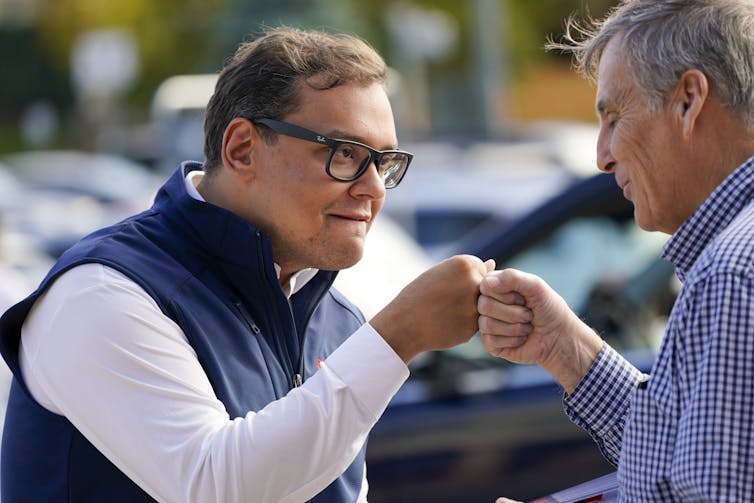
Fool me once …
Just because someone speaks confidently, dresses well and acts friendly does not mean the person is honest. Pay attention to what people say – the content of their verbal messaging.
Don’t fall prey to body language or seemingly sincere behavioral impressions, which actually have no correlation to actual truthfulness. As my research has shown, the appearance of sincerity is misleading. It is a myth that eye contact means someone is telling you the truth and that a roving gaze or elevated blinking means they are lying.
Some people just look honest but they are pulling the proverbial wool over your eyes. Some people look sketchy and appear unbelievable, but what they say is truthful.
Santos’ disgrace is a teachable moment for citizens. As the proverb goes: Fool me once, shame on you; fool me twice, shame on me.
David E. Clementson does not work for, consult, own shares in or receive funding from any company or organization that would benefit from this article, and has disclosed no relevant affiliations beyond their academic appointment.
Destruction of Ukrainian heritage: why losing historical icons can leave a long shadow
Destruction of Ukrainian heritage is happening on a scale not seen there since World War II, a report published by the journal, Antiquity, has claimed.
The report lists damage to a number of historic sites, including the Unesco-listed Vasyl Tarnovsky Museum of Ukrainian Antiquities and the burial mound at Boldyni Hory – one of the largest eleventh-century Ukrainian necropolises. Since the war began, Unesco has verified damage to 329 sites, including to the historic centre of Chernihiv.
It adds that collections have been expropriated and transferred to Russia from museums in occupied regions, including Kherson (now back under Ukrainian control), Melitopol and Mariupol, while in other cases artefacts have been pillaged by Russian soldiers to keep or sell. Researchers are using satellite data as well as on-the-ground assessments to document the destruction of Ukraine’s cultural heritage.
It was damage to heritage during World War II that prompted the United Nations to put together the Convention for the Protection of Cultural Property in the Event of Armed Conflict (also known as the 1954 Hague convention). This made it a war crime to destroy “cultural property” (the term used to describe tangible heritage) except in cases of military necessity.
The 1954 convention envisaged a scheme for the protection of heritage in war that would parallel schemes for the protection of people. Like the red cross emblem that effectively removes things such as ambulances and hospitals from the danger of attack, there was to be an emblem, a blue and white shield, that should create awareness (and protection) of important museums, monuments, archaeological sites, archives and libraries.
An additional protocol proposed that there be an organisation, The Blue Shield), to protect cultural heritage in emergency situations.
Although this got off to a relatively slow start. The UK ratified the convention in 2017 – the last major military power to do so. The convention mandates states to have “cultural protection units” as part of the regular armed forces – the UK set one up in 2019. The prompt for this activity was the widespread destruction of heritage in the Middle East, notably parts of Palmyra in Syria by ISIS and the destruction of the Mosul Museum in Iraq.
The west has its own sins to count here: during the invasion of Iraq, the Americans set up a large military base on the site of Ancient Babylon and did extensive damage including using thousands of tons of archaeological material to fill sandbags.
Despite all this, as the report on Ukraine makes clear, there are limits to what can be achieved. Part of the problem is that it is just difficult to persuade armies to be careful about buildings when they are shooting and/or being shot at. Despite signing up, states have not really put much effort into implementing the convention.
There are few sites marked with the blue and white shield in the world, and it is not obvious that it would help them much if they were marked with the shield. (I have one of the shields upstairs – a despairing member of The Blue Shield gave it to me as a keepsake). There are some commendable efforts to train regular soldiers in the heritage legislation, but they have a lot of other calls on their attention.
Although Ukrainians will survive this loss it is, nonetheless, a loss. Sometimes this is tangible; a ruined town bereft of history is unlikely to attract tourists and revenue. Sometimes it is less tangible. Links with the past are destroyed, there is a loss of opportunity to continue a way of life, to live in the place one’s parents and grandparents lived, to go to the same church or even the same cafe. When these things are gone we can never get them back.
Other countries have tried to replace what had been destroyed. The Poles, for example, reconstructed the historic centre of Warsaw, which had been levelled by the Nazis.
But what people want is history, not a copy of history. Also, by that stage, there might be other demands on scarce resources – as Lynn Meskell, professor of anthropology at Penn State University has argued, sometimes we need toilets first and temples second.
Why protect buildings?
It would be optimistic to think the Russians were worrying too much about the Hague convention (although they, like the Ukrainians, are signatories). However, if they were, the uncertainties at its heart would not help. For the past few years, Helen Frowe, director of the Stockholm Centre for the Ethics of War and Peace, and I have been trying to clarify matters. Central to these issues are the “stones versus lives” debate: given limited resources, should we focus on preserving culture (stones) or people (lives)?
The standard reply to this is that concern for heritage and concern for people are inseparable. Thomas G. Weiss and Nina Connelly, cultural heritage experts based at the City University of New York, have gone as far as to set out how an expansion of the “responsibility to protect” legislation may justify the case that it is right to go to war to prevent heritage being destroyed.
Frowe and I take a different view. We do not think choices between heritage and people can generally be avoided.
Earlier I said that the Hague convention outlaws the destruction of cultural property except in cases of military necessity, where there’s “no feasible alternative available to obtain a similar military advantage” (Article 6). But is an alternative feasible if it saves the cultural property, but increases the risk to soldiers by 5%? What about 10%? Without some way of making such calculations, the convention is toothless.
Artefacts that have been around for a thousand years or more have been destroyed in Russia’s illegal war. However, facing up to the issues, which includes improving this international legal structure, might help prevent some destruction of cultural treasures in the future.
Derek Matravers receives funding from the AHRC grant: AH/P015077/1, 2017-2020.




